R>
ANCIENT ROMAN ART
SOLD ITEMS
CLICK GALLERIES AT LEFT FOR CURRENT INVENTORY
|
8713. HUGE ROMAN SILVER GLOVE RING, c. 1st-3rd century AD. The huge ring designed either for a huge finger or to be worn over a glove, the bezel set with an extremely fine 12mm x 16mm deeply carved carnelian intaglio of the horned head of Zeus Ammon. 35mm, 27mm internal diameter. Choice quality and condition and wearable (if your finger is large enough!).
Provenance: A private Hungarian collection formed in the 1950's.  $2400. $2400.
|
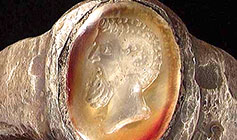 |
|
9084. EROTIC ROMAN BONE VENUS. Egypt, prob. Alexandria c. 2nd-4th century AD. The beautiful maiden standing nude except for a pleated garment fastened at her hip by a large brooch which she holds from slipping down over her body or perhaps she is in the process of removing it. 3.2 inches. A wonderful figure charged with eroticism and in excellent condition. Backside view.  $650. $650.
|
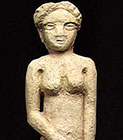
|
|
8138. SUPERB ROMAN MOLOSSIAN HOUND, c. 1st-2nd century AD. The large breed dog stands alertly atop a large decorative oval wearing a heavy collar. Museum quality with great classical style and fine engraved details. Choice condition but for the missing tip of the r. ear. The large and vicious Molossian hounds were used by the Romans to bring down bulls and wild beasts and to kill prisoners in the arena. 3.25 inches on original integral stand.  $6500. $6500.
|
 |
|
8715. A FINE ROMAN TWISTED SILVER BRACELET, c. 1st-3rd century AD. The bracelet with finely symmetric twists tapering to the open ends. 2.4 inches. 36.49 gm. Choice example in excellent condition.  $850. $850.
|
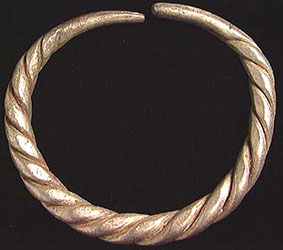 |
|
6797. A CHOICE ROMAN CAMEO, c. 1st-2nd century AD. The cameo carved from layered opaque white on black glass in fine classical style with a young male head facing l. Stable lines. 1.2 x 0.9 x 0.4 cm. Very rare this nice!  $2450. $2450.
|
 |
|
8720. ROMAN BRONZE ATTACHMENT IN THE FORM OF A SPHINX, Provincial style, c. 1st-3rd century. The solid cast attachment with concave back probably originally from a bronze vessel, cast in the form of a facing sphinx, her wings at her sides. 2.6 inches. Very rare and in excellent condition.  $450. $450.
|
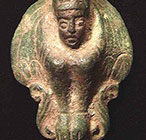 |
|
8303. A ROMAN BRONZE BOWL, c. 1st-3rd century AD. Sizable shallow bowl with rolled rim with two suspension holes for hanging on kitchen wall. 7.5". Small press spot but nice condition. Attractive blue and green deposits on bottom. Scarce.  $850. $850.
|
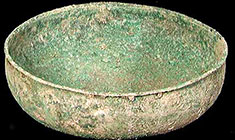 |
|
11130. ROMAN LEGIONARY TILE, c. 1st century BC - 2nd century AD. FNIRE (retrograde) stamp of Legion Exeritus Germanicus Inferior. The entire stamp would read EX GER INF. 1 x 4 x 5 inches.  $350. $350.
|  |
|
12251. COMPLETE ROMAN BUILDING BRICK WITH LEGIONARY STAMP. PL107 Tile Roman, red, "LEGVIIIA..GA", Legio VII Augusta. Chip to upper right corner. Inscription much clearer than photo, all legible. 203x185. Provenance: The University Collection.  $450. $450.
|
 |
|
12266. RARE ROMAN WALL FRESCO FRAGMENT. BM126 Very rare fresco fragment from a Roman wall with cream, yellow, red, and black pigments. 15 x 9.3 cm. Found in Germany. Provenance: The University Collection.  $850. $850.
|
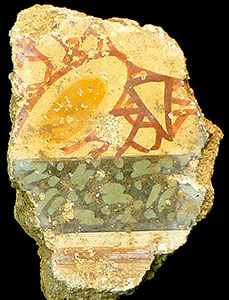 |
|
8139. CHOICE ROMAN ORICHALCUM CROSSBOW FIBULA, c. 2nd-3rd century AD. The heavy crossbow fibula (a type of decorative cloak fastener or brooch) in choice coindition with the original pin save for a small tear on the left terminal. Professionally cleaned down to the original orichalcum metal. Orichalcum was an alloy of copper and zinc that gleamed like gold as you can see in this fine example which looks just as it would have when originally made and proudly worn. 1.75 x 3 inches. SOLD.
|
 |
|
12953. ROMAN MILITARY DIPLOMA. Large section of a bronze auxiliary diploma. Moesia Superior, issued under Trajan, 103-111 AD. (63x53mm). Green and brown patina. Surface crack. Clear inscription.
Side A:
[IMP CAESAR DIVI NERVAE F] NERVA TRAIANVS
[AVGVSTVS GERM DACICVS] PONTIFEX MAXIMVS
[TRIBVNIC POTESTAT --]IMP IIII COS V P P
[EQVITIBVS ET PEDITIBVS QVI] MILITANT IN ALIS
[DVABVS ET COHOR]T SEPTFM QVAE AP
[PELLANTVR II PANNO]NIORVM ET PRAE
[TORIA SINGVL ET III BRITT VE]TERANA ET I FLA
[BESSORVM ET I ANTIOC]HENSIVM ET I
[--ET I MONTANRV]M C R ET I CISIPA
[PADENSIVM ET II VINDE]LICORVM äš_ C R
[--]+NA
Side B:
LICO[RVM äš_ C R ET I THRACVM SYRIACA ET I]
CILIC[VM ET ä_ñET III AVG NER]
VIANA BRITTO[NVM ä_ñ ET IIII]..
RAETORVM ET [V HISPANORVM ET VI THRA]
CVM ET VII B[REVCORVM ET SVNT IN MOESI]
A SVPERIORE [SVB --]
QVI QVINA ET [VICENA ITEM CLASSIC SENA ET]
VICENA PLVR[AVE STIPENDIA --]
Roman Military Diplomas, sometimes mistakenly called Roman Legionary Diplomas, were issued to Roman Auxiliary soldiers upon completion of their standard 25 year term of service. While Roman legionary soldiers were composed only of Roman citizens, the Roman Auxiliaries were non-citizens drawn from the various Roman provinces. The purpose of these military diplomas was to convey Roman citizenship upon the retiring auxiliary soldier in return for his years of service. Retiring Roman Auxiliaries were also often given land in one of the Roman Colonias. The Auxiliary would present his military diploma to the local authorities as proof of his newly acquired Roman citizenship. Diplomas are usually found in fragmentary form as they were often broken into smaller and smaller fragments and the pieces distributed among the male descendants to prove their heritage. Roman Military Diplomas were issued from the reign of Claudius until around 212 AD when the Constitutio Antoniniana, issued by the emperor Caracalla, granted Roman citizenship to all inhabitants of the empire. Through much of this period the Roman Auxiliaries composed the majority of the Roman army, and nearly all its specialized forces. Only around 800 genuine Roman Military Diplomas are known, and as such they are quite rare and important Roman historical documents.
SOLD. |
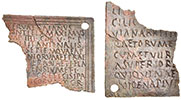
|
|
PUBLISHED IN ROMAN MILITARY DIPLOMAS - VERY RARE
11430. ROMAN MILITARY DIPLOMA. 2nd century before 140 AD. 6 x 7 cm. Awarded to an auxiliary soldier from the tribe of the Breuci in Pannonia. His wife also came from this tribe. They had three children, two sons and one daughter. A larger than usual fragment with clear inscription. Reverse inscription. Front patina. Reverse patina.
Side A:
[--]+++
[--]O COS
[--]EST
[--]LINVS
[--]
[--]BREVC(O)
[--]RI EIVS BREVC(AE)
[--]F EIVS
[--]F EIVS
[--]FILIAE EIVS
[--]EX TABVLA AENEA (as written on this bronze tablet)
Side B:
[--] HOMERI ("seal of Homerus", one of the witnesses recorded on the reverse of the diploma.)
[--]++IAVI
[--]+I
Roman Military Diplomas, sometimes mistakenly called Roman Legionary Diplomas, were issued to Roman Auxiliary soldiers upon completion of their standard 25 year term of service. While Roman legionary soldiers were composed only of Roman citizens, the Roman Auxiliaries were non-citizens drawn from the various Roman provinces. The purpose of these military diplomas was to convey Roman citizenship upon the retiring auxiliary soldier in return for his years of service. Retiring Roman Auxiliaries were also often given land in one of the Roman Colonias. The Auxiliary would present his military diploma to the local authorities as proof of his newly acquired Roman citizenship. Diplomas are usually found in fragmentary form as they were often broken into smaller and smaller fragments and the pieces distributed among the male descendants to prove their heritage. Roman Military Diplomas were issued from the reign of Claudius until around 212 AD when the Constitutio Antoniniana, issued by the emperor Caracalla, granted Roman citizenship to all inhabitants of the empire. Through much of this period the Roman Auxiliaries composed the majority of the Roman army, and nearly all its specialized forces. Only around 800 genuine Roman Military Diplomas are known, and as such they are quite rare and are important Roman historical documents.
Published in Roman Military Diplomas by Dr. Paul Holder.
SOLD. |

|
|
8731. A HEAVY ROMAN CROSSBOW FIBULA, c. 2nd-4th century. The large bronze fibula with heavily knobbed cross, the flat tail ornamented with incised annulettes. 3.3 inches. Rare this large.  $150. $150.
|
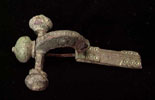 |
|
12954. ROMAN MILITARY DIPLOMA. Two large sections of a bronze auxiliary diploma making up almost the entire plate. Time of Hadrian, circa AD 122. (132x92mm [combining the two pieces]). Green and red patina.
Side A:
[--DVMTAXAT SI]NGVLI SINGVLAS
[A D] XVI K AVG
[Ti Iulio]CAPITONE COS
[L Vitrasio]FLAMININO
[--]VIEI
[--]BESS(O)
[--]F EIVS
[--]F EIVS
[--]F EIVS
[--]FIL EIVS
Side B:
[TI IVLI] VRBAN[I]
[A FVLVI] IVSTI
[P ATINI] FLORI
[L PVLLI] DAPHNI
[Q LOLLI] FESTI
[L NONI VICTO]RIS
[C VETTIENI] HERMETIS
Roman Military Diplomas, sometimes mistakenly called Roman Legionary Diplomas, were issued to Roman Auxiliary soldiers upon completion of their standard 25 year term of service. While Roman legionary soldiers were composed only of Roman citizens, the Roman Auxiliaries were non-citizens drawn from the various Roman provinces. The purpose of these military diplomas was to convey Roman citizenship upon the retiring auxiliary soldier in return for his years of service. Retiring Roman Auxiliaries were also often given land in one of the Roman Colonias. The Auxiliary would present his military diploma to the local authorities as proof of his newly acquired Roman citizenship. Diplomas are usually found in fragmentary form as they were often broken into smaller and smaller fragments and the pieces distributed among the male descendants to prove their heritage. Roman Military Diplomas were issued from the reign of Claudius until around 212 AD when the Constitutio Antoniniana, issued by the emperor Caracalla, granted Roman citizenship to all inhabitants of the empire. Through much of this period the Roman Auxiliaries composed the majority of the Roman army, and nearly all its specialized forces. Only around 800 genuine Roman Military Diplomas are known, and as such they are quite rare and important Roman historical documents.
 $6000. $6000.
|
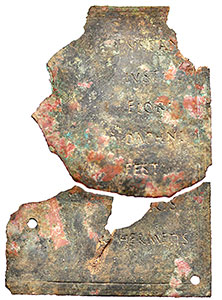
|
|
11249. ROMAN RIBBED GLASS BOTTLE, circa 4th century AD. Flaring rim, cylindrical neck, globular body with diagonal ribbing. Bluish-green tint. Height: 17.0cm. Intact.
Provenance: Acquired from CNG by current owner.  $1450. $1450.
| 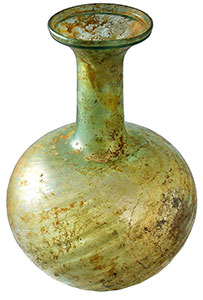 |
|
8151. TWO ROMAN BRONZE MEDICAL INSTRUMENTS, c. 1st-3rd century AD. One with a small angled disc with sharp edges, the other finely made with a large blade and engraved handle. To 6.5 inches.
Provenance: A private Hungarian collection formed in the 1950's.  $250. $250.
|
 |
|
7645. ROMAN BRONZE PRIAPUS, c. 1st-2nd century AD. The bearded god raising the front of his robe to reveal his large erection on which he supports an assortment of fruits and grape bunches. 3 inches. A rare and desirable type known from finds at Pompeii.  $1250. $1250.
|
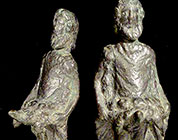 |
|
7646. EROTIC ROMAN ATTIS TELESPHOROS, c. 1st -2nd century AD. Depicting the god Telesphoros dressed in Asiatic robe with peaked hood, the front of which he raises to reveal his large erect member on which he supports an assortment of fruits. 2.6 inches. A rare depiction.  $1250. $1250.
|
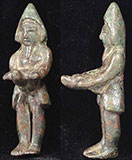 |
|
6880. EROTIC ROMAN NUDE HARPOCRATES, c. 1st-3rd century. The young boy god stands nude in the traditional posture with his finger to his mouth holding an uncertain object in his other hand. 3.3". Nice detail & condition and very charming.  $1450. $1450.
|
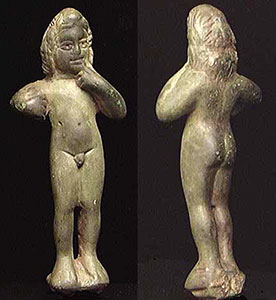 |
|
6881. A ROMAN BRONZE FIGURE OF A LAR, c. 1st-3rd century. Classic figure of a Lar (a Roman household god) wearing a tunic belted at the waist. Excellent detail front and back. 3". Better than photo.  $1650. $1650.
|
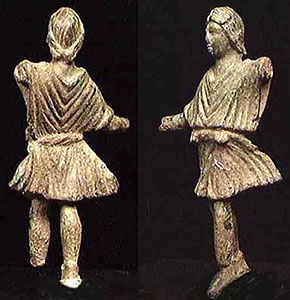 |
|
8305. ROMAN BOY ON A DOLPHIN RING, c. 1st-3rd century AD. Bronze ring with bezel engraved with a scene of 3 frolicking dolphins, a boy riding the largest one. 19 x 22mm external. Intact with good detail. A classic ancient motif. Side 1. Side 2.  $350. $350.
|
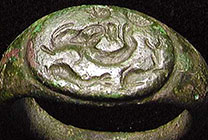 |
|
7560. A FINE ROMAN BRONZE FIGURE OF MERCURY, Circa 1st-3rd Century AD. Mercury (Greek Hermes) was not only the messenger of the gods, but the god of merchants and thieves as well. Here he is depicted with his winged hat holding a purse to signify his connection with wealth and success in business.
He stands nude except for a cape curled round his arm and a traveling cap (petasos) with wings. In his right outstretched hand he carries a leather purse filled with coins. On a custom stand. Height: 8.4 cm. (3.3"). Metal composition: Solid cast bronze with natural hard green patina. Condition: The left hand lost in antiquity, otherwise in choice condition with better facial detail than shows in the image.
Provenance: Acquired at Harmer Rooke Galleries in the early 1990's. Independent documentation it's been in the US since at least July 1997.  $1650. $1650.
|
 |
|
7547. A FINE ROMAN GOLD APPLIQUƒ OF ZEUS AMMON, c 1st-3rd century AD.
Finely worked very high profile sheet gold repousse attachment of the horned god. 1.6”. Rare and in choice condition!
Provenance: Acquired at Harmer Rooke Galleries August, 1998.
 $1250. $1250.
|
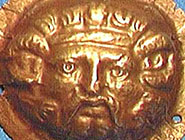 |
|
EXTREMELY RARE ROMAN LEGIONARY SOLDIER'S PUGIO
12433. A CLASSIC FORM ROMAN LEGIONARY DAGGER. 1st century AD. Made of iron with the distinct classic pugio form with round pommel and knobbed handle, the blade curving slightly inward below the hilt to a straight blade before curving in again to the point. 12 inches. The Roman pugio was the official standard issue dagger carried by the Roman Legions. Photo of the reverse.
The pugio (plural: pugiones) was a dagger used by Roman soldiers as a sidearm. It seems likely that the pugio was intended as an auxiliary weapon, but its exact purpose to the soldier remains unknown. Officials of the empire took to wearing ornate pugios in the performance of their offices, and some would wear concealed pugios as a defense against contingencies. The pugio was a common weapon of assassination and suicide; for example, the conspirators who stabbed Julius Caesar used pugios. Made of iron they rarely survive, thus complete intact examples such as this are extremely rare. See the Wikipedia article here. See museum examples and more information here.
Provenance: The Emeritus Collection formed in the US by the vice-president of a university from the 1950's to 80's.  $6,500. $6,500.
|
 |
|
12810. ROMAN BRONZE OIL LAMP. Late Roman early Byzantine. 5 inches. Unusual perforated lid. Complete and intact with original lid. Provenance: The University Collection. Verso.  $750. $750.
|
 |
|
CHOICE EXAMPLE
12780. ROMAN BRONZE OIL LAMP. c. 300 AD. Dove on the handle and lid in form of scallop shell.
M
42
Gray Green
5.8 x 14.0 cm. Intact and complete.
Provenance: The University Collection. Verso.  $1450. $1450.
|
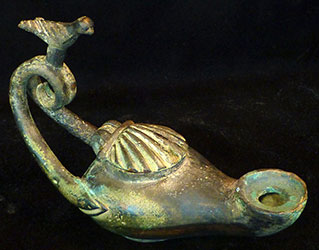 |
|
7257. A RARE EARLY ROMAN BALLISTA BOLT, 3rd-1st century BC. The bronze ballista bolt of large arrowhead form with tenon on trailing end. The Roman ballista was a large stationary crossbow that was mechanically wound up and shot bolts with tremendous force. It was the Roman equivalent of a small artillery piece. Very rare and in excellent condition. 2.25 inches. Dr Mike Bishop, co-author of Roman Military Equipment, suggests that this could also be a rarer Hellenistic ballista bolt.  $450. $450.
|
 |
|
6890. LARGE ROMAN BRONZE PATERA, c. 1st-3rd cent. The heavy vessel with classic Pompeian style ribbed base. Intact with encrustation. Small hole one edge. 13" across the handle. Rare large intact Roman bronze vessel.  $1250. $1250.
|
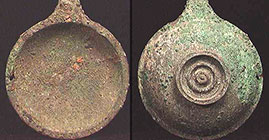 |
|
12821. ROMAN BRONZE OIL LAMP.
M
67
Brown
Leaf
No
Y
4.8 x 13.3 cm.
200AD. Complete and intact. Provenance: The University Collection. Verso.  $750. $750.
|
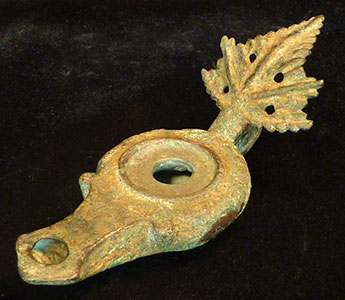 |
|
12789. ROMAN BRONZE OIL LAMP.
M
64
Green
Leaf
No
Y
6.3 x 12.5 cm.
100BC. Intact with missing lid. Provenance: The University Collection. Verso.  $500. $500.
|
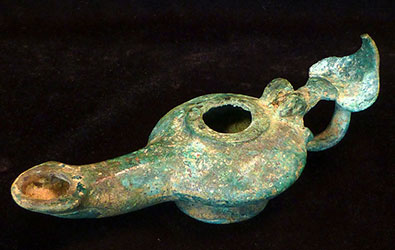 |
|
9069. IMPRESSIVE PALMYRAN LIMESTONE PRIESTESS. Roman Syria, c. 2nd century AD. The sizable limestone figure of the robed and veiled priestess holding a patera (offering bowl) and staff of authority. 6 x 10.5 inches. Rare. Better detail than photo. Front view. Left side. Right side. Back view.
Provenance: A private American collection with independent 3rd party documentation establishing US ownership since at least November, 1999.  $850. $850.
|
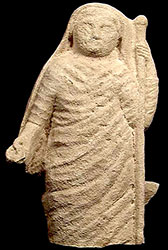
|
|
7561. A ROMAN BRONZE ATTACHMENT, c. 1st-3rd century AD. In ancient times attachments like the current fine example were used to ornament wooden chests or pieces of furniture.
Finely cast bronze applicae in the form of the facing head of an Erote with long curly hair drawn into a top knot. Diameter: 44 mm. (1.73"). Depth: 18 mm. (0.71"). Weight: 48.71 gm. (1.714 oz.). Metal composition: Bronze with natural brown and green patina, small area of modern solder on reverse, plugged hole on top rim. Condition: Excellent.  $450. $450.
|
 |
|
9085. RARE ROMAN TERRA SIGILLATA SHARD DEPICTING OCEANUS. c. 3rd-5th century AD. The red ware fragment of the rim of a bowl with a fine facing head of Oceanus, with wide double beards and horns in the form of lobster claws. Oceanus' image often appears on opposite sides of a dish with two fish on the other sides; for a complete plate, see Salomonson, 1969, p. 102 (Pl. II 6 = Louvre AO 6639). The shard 3.7 inches. Choice example of a rare depiction of Oceanus.  $150. $150.
|
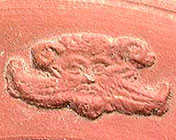
|
|
7651. SIZABLE ROMAN BRONZE STEELYARD WEIGHT, c. 1st-2nd century AD. The applique in the form of the bust of a noblewoman or empress wearing an ornate headdress, large loop at top. 3.3 inches. Fine classical style.  $350. $350.
|
 |
|
12914. SMALL ROMAN MARBLE HEAD OF A YOUTH. Eastern Mediterranean, 1st-3rd century AD. 3.25 inches. The head of a young man with wavy hair and an intent expression. On professional black plastic stand.
Another view.
Another view. Another view. On stand.
Provenance: A private East Coast collection formed during the late 20th century.  $750 $750
|
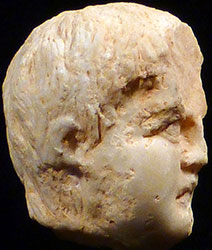
|
|
8726. A ROMAN FIBULA WITH INSCRIPTION, c. 1st-3rd century. The bow type bronze fibula with inscription LoVII molded in the terminal. 2 inches. Rare.  $250. $250.
|
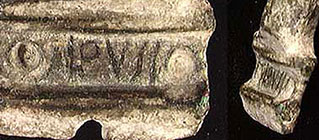 |
|
8018. ROMAN PERSONAL COSMETIC SET, c. 2nd-3rd century AD. The set consisting of ornamented tweezers and a pick on the original bronze ring with fastener. 2.75 inches from tip of fastener to tip of pick. Rare intact example.  $250. $250.
|
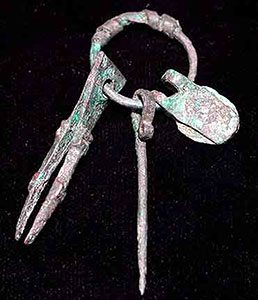 |
|
INFAMOUS ROMAN 10TH LEGION
11131. ROMAN LEGIONARY TILE, c. 1st century BC - 2nd century AD. X G partial stamp of Legion X Gemina, the famous Tenth Legion central to the Roman suppression of the Judaean revolt. 1 x 4 x 4 inches.  $350. $350.
|  |
|
8727. A CHOICE ROMAN FIBULA, c. 1st-3rd century. The heavier spring loaded fibula with ornate spring retainer arching to a wide flat tail with molded and incised designs. 2.3 inches. A number of areas of gilding showing through depressions in the fine glossy patina. Original pin and spring, the whole a superb example in choice condition.  $250. $250.
|
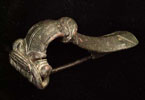 |
|
12804. ROMAN BRONZE OIL LAMP.
M
31
Green
Eagle
No
Y
5.4 x 11.5 cm.
100BC. Intact and complete. Provenance: The University Collection. Verso.  $1000. $1000.
|
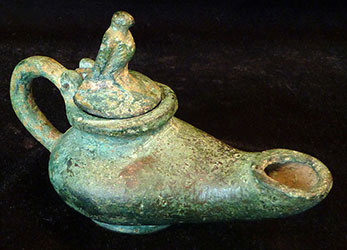 |
|
7259. A RARE EARLY ROMAN BALLISTA BOLT, 3rd-1st century BC. The bronze ballista bolt of large arrowhead form with tenon on trailing end. The Roman ballista was a large stationary crossbow that was mechanically wound up and shot bolts with tremendous force. It was the Roman equivalent of a small artillery piece. Very rare and in excellent condition. 2.5 inches. Dr Mike Bishop, co-author of Roman Military Equipment, suggests that this could also be a rarer Hellenistic ballista bolt.  $450. $450.
|
 |
|
7370. FINE ROMAN EGYPTIAN TERRA COTTA FIGURE OF A SOTHIC DOG. Roman Egypt, c. 1st-2nd century AD. The small dog reclining with legs drawn up beneath it, the short tail tightly curled, he wears a collar ornamented with three circular medallions, the hair, eyes and mouth indicated with careful incised detail. 2.4 inches. A small masterpiece! Detail both sides.
The Sothic dog of Isis was connected with the dog star Sirius, the heliacal rising of which marked the first day of the year and the coming of the yearly flooding of the Nile (the inundation). Figures of the Sothic dog were popular during the 1st and 2nd Century AD and valued for the domestic shrines as a harbinger of the New Year and to protect the household from the chaos caused by the rising waters.
Provenance: A private NJ collection. Previously from the collection of a prominent Egyptologist brought to the US in 1954 with the family.
 $650. $650.
|
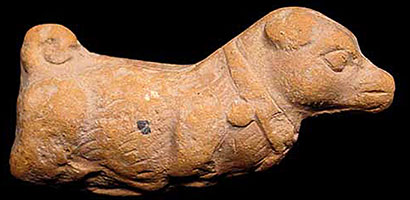 |
|
7371. FINE ROMAN EGYPT TERRA COTTA FIGURE OF A CAT. c. 1st-2nd century AD. The small cat seated on its hind legs, with tail curled forward, wearing a collar with ornaments in the front, the hair, eyes and mouth indicated with careful incised detail. Hard fired, 1.75 inches. A small masterpiece! Free standing.
Provenance: A private NJ collection. Previously from the collection of a prominent Egyptologist brought to the US in 1954 with the family.  $650. $650.
|
 |
|
10067. FINE ROMAN SILVER BRACELET, c. 1st - 3rd century AD. A fine intact and wearable Roman silver bracelet with twisted ridges interspersed with beaded rows, the two ends wrapped around and sliding over each other to give a very slight adjustment in size and aid in putting it on the wrist. A classical Roman silver bracelet of fine design in choice and wearable condition, but only for a small wrist! 2.35 x 2.5 external diameter. 2 x 2.25 inches internal diameter.  $1250. $1250.
|
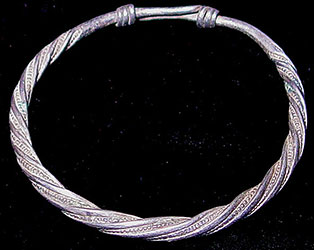
|
|
7376. LARGE LATE ROMAN COPTIC TERRA COTTA FIGURE OF A DOG. c. 1st-2nd century AD. The dog standing at attention with perked up ears and tightly curled tail, collar with pendant at front. 3.5 x 5 x 2 inches wide. One of a pair. Free standing. Intact and appealing.
Provenance: A private NJ collection. Previously from the collection of a prominent Egyptologist brought to the US in 1954 with the family.  $350. $350.
|
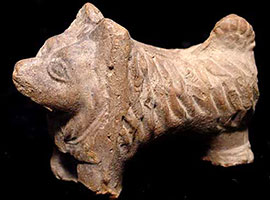 |
|
9338. A PAIR OF FINE ROMAN GOLD EARRINGS, c. 2nd-3rd century AD. Of thick twisted gold wires imitating a braided form. 22 mm. Wearable with care.  $1450. $1450.
|
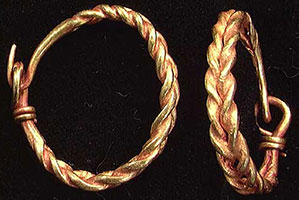
|
|
7258. A RARE EARLY ROMAN BALLISTA BOLT, 3rd-1st century BC. The bronze ballista bolt of large arrowhead form with tenon on trailing end. The Roman ballista was a large stationary crossbow that was mechanically wound up and shot bolts with tremendous force. It was the Roman equivalent of a small artillery piece. Very rare and in excellent condition. 2.5 inches. Dr Mike Bishop, co-author of Roman Military Equipment, suggests that this could also be a rarer Hellenistic ballista bolt.  $450. $450.
|
 |
|
11657. ROMAN LEGIONARY TILE WITH CANINE FOOTPRINT. Roman Province of Pannonia, c. 2nd-4th century AD. A Roman legionary building tile (baked orange clay brick) with the impression of a dog's footprint, likely the pet of a legionary soldier or local camp dog who stepped on it while it was drying prior to firing. The tile 6 x 7 x 1.25 inches, the print 2 x 3 inches. The print quite clear with excellent detail including the claw marks. Some ancient calcified deposits in the impressions attesting authenticity. A rare and poignant testimony to the life of some ancient dog from nearly two millennia ago.
Provenance: From a private Hungarian collection formed in the 1960's.  $250. $250.
|
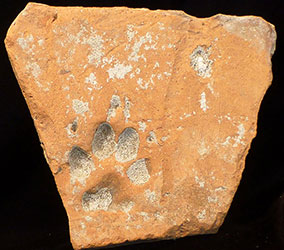
|
|
11660. FINE ROMAN BUCKLE WITH BUSTS OF AN EMPEROR AND EMPRESS. Roman Province of Pannonia, c. 4th century AD. Finely constructed bronze buckles with two Constantinian style busts, likely that of a Constantinian emperor and empress. 1.75 x 1.75 inches. A very rare type of buckle. Covered with an excellent smooth forest green patina.
Provenance: From a private Hungarian collection formed in the 1950's. Back view.  $650. $650.
|

|
|
SCARCE TWO SPOUT LAMP
12813. ROMAN BRONZE OIL LAMP.
M
58
Black
Crescent
No
N
7.5 x 12.0 cm.
300AD. Two spout. Provenance: The University Collection. Complete and intact. Scarce two spout oil lamp. Verso.  $1250. $1250.
|
 |
|
9733. RARE ROMAN SILVER STEP SPOON, c. 2nd century AD. The spoon with piriform bowl and six decorative incised 'X's on the step. 6.85 inches. Intact. Silver spoons were used only in wealthy Roman households. Rare. Reference: Riha/Stern, Die romischen Loffel.
Provenance: The Emeritus collection formed by a university Vice President in the 1960's through 1980's.
 $1650. $1650.
|
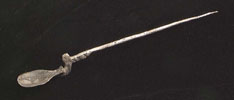
|
|
9079. A ROMAN BRONZE PATERA, c. 1st-3rd century AD. The offering bowl with (detached) handle with duck's head and engraved palmettes top and bottom. The bowl 8.75 inches in diameter, the handle 7.5 inches. Very rare. Hole on edge of bowl where handle was attached.  $650. $650.
|
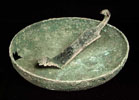
|
|
SOL HELIOS THE SUN GOD
6800. BEAUTIFUL ROMAN SILVER RING WITH CARNELIAN INTAGLIO, c. 2nd-3rd century. The heavy silver seal ring set with a large carnelian intaglio deeply carved with a radiate bust with flowing hair. 30mm wide, internal diameter 15 x 21 mm. Rare and choice! Wearable.
Provenance: A private Hungarian collection formed in the 1950's.  $1250. $1250.
|
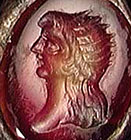 |
|
11666. FINE QUALITY ROMAN PATERA HANDLE. Roman Province of Pannonia, c. 2nd-4th century AD. The bronze patera handle terminating in the helmeted head of a warrior or priest. 1.5 x 5.25 inches. Roman pateras were shallow bronze vessels of frying pan form. They were used to make offerings during religious ceremonies.
Provenance: From a private Hungarian collection formed in the 1960's.  $450. $450.
|

|
|
12782. ROMAN BRONZE OIL LAMP. M 82 Green. With original lid in form of a scallop shell. 6.8 x 17.6 cm. 200BC. Complete and intact. Provenance: The University Collection. Verso.  $1250. $1250.
|
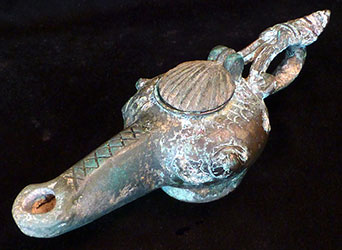 |
|
8148. FINE ROMAN BRONZE APPLIQUƒ, c. 1st-3rd century AD. In the form of a facing head with excellent features, details and a fine olive green patina. 3 inches. Choice example better than image.  $450. $450.
|
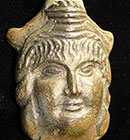 |
|
8136. BEAUTIFUL ROMAN SILVER COCKEREL, c. 1st-2nd century AD. The small solid silver rooster cast and engraved with a wonderful life-like expressive pose and fine detailing with its head turned to the side in an alert listening position. 13 x 22 x 25mm.
A small museum quality treasure and extremely rare! Choice intact condition on original base.
Provenance: Ex. Christies.  $2250. $2250.
|
 |
|
8304. ROMAN SILVER 'FEDE' RING, c. 1st-3rd century AD. With clasped hands symbolizing fidelity, familiar from coins, on the bezel. 18 x 20 mm. Rare. Wearable and a fine gift for a spouse or friend.  $850. $850.
|
 |
|
VERY RARE
11664. ROMAN SIGNALING ARROWHEAD. Roman Province of Pannonia, c. 2nd-4th century AD. The special purpose arrowhead made of iron with wide flat head pierced by two holes and strengthened by a central rib. 4.3 x 2 inches. Very rare and an excellent example in excellent condition especially for an ancient iron artifact. These rare arrowheads were used to fire attached streamers overhead for signaling legions during combat.
Provenance: From a private Hungarian collection formed in the 1960's.  $500. $500.
|
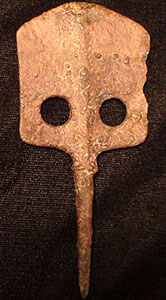
|
|
8725. ROMAN FIGURAL SUNBURST BROOCH, c. 1st-3rd century AD. The bronze brooch with the head of a goddess wearing a necklace with three large pendants and a turetted crown, all centered in a sunburst or floral device. 1.6 inches. Said to have been found in the Holy Land. A rare type, and with excellent condition and beautiful style and composition.  $250. $250.
|
 |
|
8724. A ROMAN LEAD BULLA WITH INSCRIPTION, c. 1st-3rd century. The rectangular seal with vertical cord hole and a three line Latin inscription with most letters clear. 1.2 inches.  $300. $300.
|
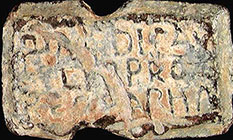 |
|
RARE TRIPLE SPOUT LAMP
12809. TRIPLE SPOUT ROMAN BRONZE OIL LAMP, c. 300 AD. Intact rings to hang on suspension chain.
M
34
Grey green on wide pedestal base. 3 spouts in the form of upturned scallop shells.
4 inches from spout to spout. Intact with original rings for suspension chain and in excellent condition. Less contrasty patina than photos.
Provenance: The University Collection. Verso.  $400. $400.
|
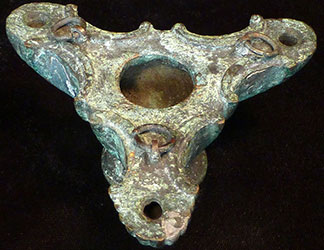 |
|
12788. ROMAN BRONZE OIL LAMP.
M
61
Brown
Crescent
No
Y
2.25 x 4.75 inches. Intact and complete with smooth grey-green patina. Nice example.
200AD. Provenance: The University Collection. Verso.  $850. $850.
|
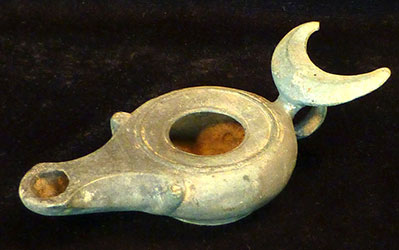 |
|
7377. LARGE LATE ROMAN COPTIC TERRA COTTA FIGURE OF A DOG. c. 1st-2nd century AD. The dog standing at attention with perked up ears and tightly curled tail, collar with pendant at front. 3.5 x 5 x 2 inches wide. One of a pair. Free standing. Intact and appealing.
Provenance: A private NJ collection. Previously from the collection of a prominent Egyptologist brought to the US in 1954 with the family.  $450. $450.
|
 |
|
8306. A LARGER ROMAN GLASS BOTTLE, c. 1st-3rd century. Globular base with tall neck and conical interior base. 7.5". Intact, light calcium deposits.  $450. $450.
|
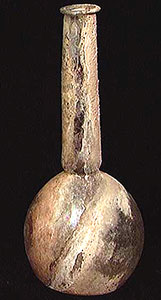 |
|
9091. A LARGE ROMAN GLASS VIAL, c. 1st-3rd century AD. The vial with very tall neck (repaired) with rolled rim and beehive base with conical interior decanter base with pontil mark. 7.4 inches. Light lime deposits and iridescence.  $450. $450.
|

|
|
9093. A FINE ROMAN GLASS DOUBLE CHAMBERED VIAL, c. 1st-3rd century AD. the bottle with double-pinched body and high neck with wide funnel rim. 5.1 inches. Intact, the body covered with silvery peacock iridescence.  $450. $450.
|

|
|
9740. ROMAN GLASS BOTTLE, c. 1st-3rd century. The larger glass vessel with globular base and high cylindrical neck with rolled rim. 6.5 inches. Excellent condition.  $450. $450.
|
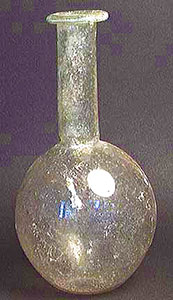
|
|
6871. A FINE ROMAN GLASS VIAL, c. 1st-3rd century. With conical body and medium neck with rolled rim. 4.1". Excellent example covered with pale milky iridescence. Scarce.  $350. $350.
|
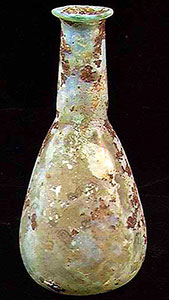 |
|
7812. ROMAN GLASS BOTTLE, c. 2nd-4th century AD. The fluted body of pale green glass. Stable lines on one side of neck, otherwise excellent condition. 2.5 inches. Scarce and better fluted glass example.
Provenance: From the estate of a prominent Egyptologist. Imported into the US in 1954.  $450. $450.
|
 |
|
11309. LARGER ROMAN GLASS FLASK, circa 4th century AD. Everted rim, long cylindrical neck, piriform body. Pale bluish-green hue with some interior cloudiness. Height: 17.6cm. Intact. A larger than usual example.  $1450. $1450.
| 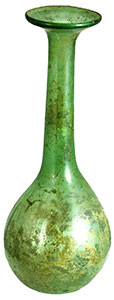 |
|
8150. IMPRESSIVE ROMAN BRONZE APPLIQUƒ, c. 1st century BC/AD. Finely styled and detailed facing head with ringlets and tiara. 1.75 x 1.75 inches. Nice example.  $450. $450.
|
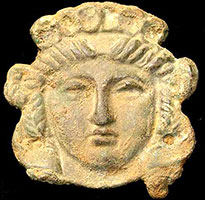 |
|
11133. ROMAN LEGIONARY TILE, c. 1st century BC - 2nd century AD. LEG II AVG stamp of Legion II Augusta, the stamp complete and clear. 1.5 x 7 x 8 inches.  $1250. $1250.
| 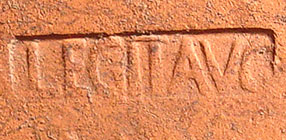 |
|
RARE ART OF THE ROMAN REPUBLIC
9697. ROMAN REPUBLIC TERRA COTTA HEAD, c. 4th - 2nd century BC. The young male head with cap over his curly hair. 4.25 inches. Light sea encrustation. Rare and of fine style. Right enlargement. Right enlargement. Rear view.
Provenance: The estate of an American artist resident in Rome just after the war. Brought to the US c. 1960.  $1850. $1850.
|

|
|
9707. ROMAN TERRA COTTA FIGURAL OIL LAMP, c. 1st-2nd century AD. The lamp with a high profile Eros leaning on a pedestal l. on the discus. 4.2 inches. Maker's signature LCAPR on bottom. Sharp excellent example.
Provenance: A private American collection. Purchased from a US antiquities dealer January, 2000.
 $395. $395.
|

|
|
12875. MASSIVE GOLD INTAGLIO PENDANT. In an original ancient gold setting probably Roman. The beautifully carved carnelian intaglio carved in an ancient Mesopotamian style but most likely Grand Tour 19th century.
Diameter: 65mm.
Weight 41 grams. Wearable with care.
Provenance: Ex London UK private collection. Larger view of carving. Side view.  POR. POR.
|
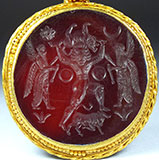 |
|
11508. A FINE ROMAN GLASS HEAD FLASK. c. 1st-2nd century AD. 12 cm. height. A choice example in excellent condition with beautiful blue swirls.
Provenance: Good and legal provenance provided to buyer. From a private Scandinavian collection. Reverse. Side A. Side B.  Price on request. Price on request.
|

|
|
11671. ROMAN GILDED SILVER SPOON WITH HIPPOCAMP AND GARNETS. 1st-4th century AD. The spoon ornamented with the figure of a Hippocamp with horse's head, humped body, and long fishy tail set with two garnets. 19 cm. length. In excellent condition with traces of gilding. Provenance: Good and legal provenance provided to buyer. Other side. Underside.  $3450. $3450.
|

|
|
12911. ROMAN BRONZE SERAPIS. Egupt, c. 1st - 3rd century AD. 53 x 38 mm. On custom plexiglas stand. Provenance: The property of a European gentleman. Side view. Reverse.  $1800 $1800
|

|
|
12913. ROMAN BRONZE DIONYSUS. Eastern Mediterranean, 1st-3rd century AD. 5.75 x 3.5 inches. Solid cast bronze figure of the god of wine holding an empty wine krater in one hand, the other raised in celebration, and wearing only a garland of vine leaves across his shoulder. Provenance: The property of a European gentleman. Another view.
Another view.
Another view. Another view.  $3500 $3500
|

|
|
12904. PAIR OF ROMAN SILVER BRACELETS. Eastern empire, c. 1st-3rd century AD. 2.25 inches diameter. Mounted on custom stand. Provenance: The property of a European gentleman. Reverses.  $1250 $1250
|

|
|
12909. ROMAN SILVER RING. Eastern Mediterranean, c. 1st-4th century AD. 27 x 13 mm, 20 mm. internal diameter. Set with very dark red black cabochon stone. Provenance: The property of a European gentleman. Reverse.  $850 $850
|

|
|
6794. AN IMPORTANT ROMAN MARBLE FIGURE OF A YOUTH. c. 2nd-3rd century AD. The large marble statue of a curly haired youth wearing a belted tunic with ornamented neck and holding a rose in his left hand. His other hand originally held an uncertain object, most likely a dove, however the statue has been altered in antiquity so that he now holds a long cross apparently with a Christogram at the top. This was certainly done by early Christians around 4th-6th century when many 'Pagan' statues were defaced or Christianized. On his back also areas where wings likely were. A beautifully carved and impressive piece, much more so than the image shows. Professional repair at neck. Height 25". Weight 73 lbs.  $8500. $8500.
|
 |
|
12902. LARGE ROMAN MARBLE HEAD. Eastern empire, c. 1st-3rd century AD. 5.25 x 9.5 inches. Intact. Free standing. Provenance: The property of a European gentleman. Enlargement. Another view. Another view.  $15,000 $15,000
|

|
|
7784. ROMAN WALL PAINTING FRESCO FRAGMENT, showing the bust of Hermes, wearing his winged hat. Nice blue, yellow, brown, white colors. Very rare fragment, found in the centre of ancient Cologne at the site of an Roman Villa. Size is 8 cm x 7 cm. About 2nd century AD. SOLD.
|
 |
|
11661. ROMAN MILITARY DIPLOMA. Roman Province of Pannonia, c. 152 AD. The small bronze fragment clearly inscribed in Latin on both sides. 20 x 25 mm. Rare. Excellent smooth forest green patina. Provenance: From an old Hungarian collection formed in the 1960's. Other side.
Side A:
[--]V NILCI
[--]+ROMQ
[--]ACM
Side B:
[--]P K I[VN/L]
[--]TVSCO
[--C]VI PRAEST
[--]VS
[--] vacat
Roman Military Diplomas, sometimes mistakenly called Roman Legionary Diplomas, were issued to Roman Auxiliary soldiers upon completion of their standard 25 year term of service. While Roman legionary soldiers were composed only of Roman citizens, the Roman Auxiliaries were non-citizens drawn from the various Roman provinces. The purpose of these military diplomas was to convey Roman citizenship upon the retiring auxiliary soldier in return for his years of service. Retiring Roman Auxiliaries were also often given land in one of the Roman Colonias. The Auxiliary would present his military diploma to the local authorities as proof of his newly acquired Roman citizenship. Diplomas are usually found in fragmentary form as they were often broken into smaller and smaller fragments and the pieces distributed among the male descendants to prove their heritage. Roman Military Diplomas were issued from the reign of Claudius until around 212 AD when the Constitutio Antoniniana, issued by the emperor Caracalla, granted Roman citizenship to all inhabitants of the empire. Through much of this period the Roman Auxiliaries composed the majority of the Roman army, and nearly all its specialized forces. Only around 800 genuine Roman Military Diplomas are known, and as such they are quite rare and important Roman historical documents.
SOLD. |
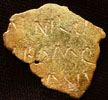
|
|
FROM A GROUP CARBON DATED TO 120 AD
9095. LARGE ROMAN IRON ADZE AXE, c. 1st-3rd century AD. Heavy socketed implement with axe on one side and adze on the other. 7.5". Nice condition. Another lot from this collection was dated by the Lawrence Livermore National Laboratory to 120 AD with a probable range of 80 AD - 160 AD. This was done using an innovative technique which measures the carbon isotope ratio of the trace carbon in the iron. This carbon comes from the wood used in the production of the iron which must be of essentially the same age as the tool itself. Results published in the journal, Radiocarbon, Summer 2001. SOLD.
|

|
|
FROM A GROUP CARBON DATED TO 120 AD
8307. A RARE ROMAN BRANDING IRON, c. 1st-3rd century AD. The branding iron with the large letters DS. 2.3 x 3.5 x7". Cf. Petrie, 'Tools and Weapons', plate LXXI. Could have been used to brand livestock or even slaves. Extremely rare and in excellent condition. Another lot from this collection was dated by the Lawrence Livermore National Laboratory to 120 AD with a probable range of 80 AD - 160 AD. This was done using an innovative technique which measures the carbon isotope ratio of the trace carbon in the iron. This carbon comes from the wood used in the production of the iron which must be of essentially the same age as the tool itself. Results published in the journal, Radiocarbon, Summer 2001. SOLD.
|
 |
|
11589. CHOICE ROMAN BRONZE COMB, c. 1st-3rd century AD. 6.25 x 4 cm. A very rare Roman comb made in bronze. Finely made with closely spaced tines suitable for removing lice and lice eggs while combing the hair. With fine glossy patina ornamented with walking hatch marks on one side. Excellent condition with all but a couple of tines remaining. Provenance: The European antiquities market. Other side. SOLD. |

|
|
11658. RARE ROMAN ENGINEERING COMPASS. Roman Province of Pannonia, c. 2nd-4th century AD. A Roman bronze engineering compass, one of the two prongs broken, the other bent. Used for transferring engineering measurements on construction plans. Quite rare example of a Roman tool. Length as is 4 inches. Provenance: From an old Hungarian collection formed in the 1960's. Underside. SOLD. |
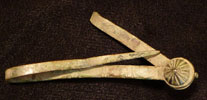
|
|
8154. CHOICE ROMAN BRONZE SPOON, ‘ligula’ type, highly decorated, goose-neck design, multiple designs on square handle, nice finial dual-design adornment, very nice decorated, heavy, ‘meaty’ example of an early roman spoon. 18 g, 135 mm long
1st to 3rd century AD. Likely used on special occasions for soup and soft food eating. Rare this nice. SOLD.
|
 |
|
7741. ROMAN VESSEL, very rare type of roman pottery. The vessel is decorated with fish scales. Found at Xanten, at the upper Rhine. Restored. Height is 12 cm. SOLD.
|
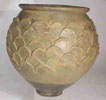 |
|
10097. TERRA SIGILATTA FRAGMENT WITH THE HEAD OF SOL HELIOS, c. 1st century BC/AD. Finely styled facing head of Zeus Serapis Sol as the central medallion of a terra sigilatta fragment. 1.5 x 1.5 inches. Sol was the Roman sun god, identified by his radiate head. Very artistic. SOLD. |

|
|
FROM A LIFE SIZED STATUE
9737. LARGE ROMAN BRONZE FOOT FROM A LIFE SIZED STATUE, c. 1st-3rd century AD. The foot from a large life size bronze statue of a male God or emperor. The five toes clearly modeled with the nails, the hem of a long robe visible above them. The underside made hollow (indicating that the statue was seated and the feet did not bear its weight), an ancient patinated rectangular patch visible at the join of the two outer toes. 4.5 x 5 x 2.5 inches. Excellent sea green patina throughout. Extremely rare fragment of a life size bronze statue from antiquity. Close up. Close up. Close up. Close up. Close up. SOLD.
|
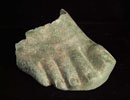
|
|
7742. ROMAN STATUE OF MERCURIUS, complete with the original base. Mercurius is wearing his winged hat and carrying a caduceus and a money purse. The condition is untouched, with only a basic cleaning done. Nice green patina, some small deposits.
The statue is not refixed on the base ! Nice detailed work at all parts. The statue was found in Cologne. High is 8 cm with base, 6 cm without. Choice roman bronze artwork. SOLD.
|
 |
|
THE EMPEROR HADRIAN'S YOUTHFUL LOVER
7648. CHOICE ROMAN BRONZE BUST OF ANTINOUS, c. 1st-2nd century AD. The youthful favorite of the emperor Hadrian depicted bare chested wearing a bulla on a necklace around his neck, his hair falling in thick ringlets. 2.5 x 3.25 x 1.25 inches. Three holes in around the margins and two in back of head for attachment. SOLD.
|
 |
|
7642. SUPERB CLASSICAL ROMAN BRONZE MINERVA, c. 1st-2nd century AD. The bust of the goddess depicted emerging from a lotus and wearing a wonderful large crested Corinthian helmet. 1.5 x 4.4 x 1.5 inches. A museum quality piece. SOLD.
|
 |
|
7563. A LARGE ROMAN MARBLE HEAD OF A MAN, c. 1st-3rd Century AD. The near life-size head of a man rendered in a sensitive, provincial style with thick, curly hair and beard and finely cut features. The back is flat and the piece may have originally come from a relief. Mounted on a custom stand. Dimensions: 23 x 19 x 12 cm. (9.2 x 7.5 x 4.8"). Weight with base: 9.4 kg. (21 lb.). Composition: Fine-grained white marble. Condition: An original ancient marble with much of the surface smoothed and over cleaned, small chip to tip of the nose. Some of the facial patina apparently restored. Comparable pieces would sell for two to three times our price without the smoothing.
|
 |
 $2500.
$2500.
|
8135. CHOICE ROMAN/DACIAN SHIELD BOSS, c. 1st-3rd century AD. The heavy bronze shield boss in the form of a facing head, likely a Medusa. It would have been ornamented the center of an upper class warrior’s shield. 3.75 inches diameter. Excellent condition with remains of iron attachment pins. SOLD.
|
 |
|
6312. A RARE ROMAN LEGIONARY INTAGLIO, c. 1st-3rd century AD. The carnelian intaglio clearly inscribed VET(ERANVS) AVG(V)S(TA) L(EGIONIS) meaning the wearer was a veteran of military service in the Roman Legion, Legio Augusta Traiana. 15mm. Very rare and collectible. SOLD.
|
 |
|
11132. LEGION I MINERVA ROMAN LEGIONARY TILE, c. 1st century BC - 2nd century AD. L I MI stamp of Legion I Minerva, the stamp complete and clear. 1.5 x 7 x 11 inches. SOLD.
|  |
|
7751. ROMAN IVORY PYXIS, depicting Eros swimming with a dolphin. Repaired from three fragments, this extremely rare ivory pyxis depicts a famous scene from Roman mythology. Found in Cologne. Height 5.8 cm. Circa 2rd century AD. SOLD.
|
 |
|
6876. A FINE ROMAN IVORY HEAD. Asia Minor or Syria, c. 1st century BC/AD. The finely carved head wearing a Phrygian helmet. A little gem! 24 mm. SOLD.
|
 |
|
8714. A FINE ROMAN AMBER INTAGLIO. Roman Republic, c. 1st century BC. Reddish yellow amber carved with the head of Minerva or Roma wearing a crested helmet l., with three additional hidden heads emerging from the chest, shield, and top of head. 12 x 14 mm. A marvelous and excessively rare example of ancient gem engraving. In excellent condition. Cf. Munich 2553, Hague 326 for related examples. SOLD. |
 |
|
8711. BEAUTIFULLY CARVED ROMAN SILVER INTAGLIO RING, c. 3rd-4th century AD. The ring set with a large (12 x 16 mm) and fine red carnelian deeply carved with the diademed bust of a handsome youth with cape over one shoulder. 29 mm, 14 x 21 mm internal. The ring is choice quality and complete and in excellent condition, one half in shadow in image. Side view SOLD |
 |
|
7785. ROMAN OMEGA BROOCH, with nice bright green patina, with a stylizied wolfs head.. Diameter is 4.5 cm.
About 3rd century AC. SOLD.
|
 |
|
6361. Roman fibula w mosaic glass inlay, II c. AD, 2" x1.6". SOLD.
|
 |
|
6362. Roman fibula w mosaic glass inlay, II c. AD, 1.9" x1.6". SOLD.
|
 |
|
6363. Roman fibula w mosaic glass inlay, II c. AD, 1.9" x 1.5". SOLD.
|
 |
|
6373. Bronze Roman buckle, I-III cc AD, Europa & Zeus, 2.5" x 2.1". SOLD.
|
 |
|
6453. Two Roman gold pendants, in crescent form, II-III c AD, 19 x 20 mm. SOLD.
|
 |
|
11524. ROMAN GOLD RING SET WITH A RUBY. 1st-2nd century AD. Side view. Provenance: A London collection. Good and legal provenance provided to buyer. SOLD. |

|
|
11523. ROMAN EROTIC GOLD RING. 1st-2nd century AD. Set with an intaglio carved with a Priapus. Another view. Provenance: A London collection. Good and legal provenance provided to buyer. SOLD. |
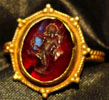
|
|
11527. ROMAN EROTIC GOLD RING. 1st-2nd century AD. Set with an intaglio carved with a Priapus. Provenance: A London collection. Good and legal provenance provided to buyer. SOLD. |
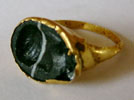
|
|
10049. CHOICE ROMAN GLASS VIAL WITH LOVELY IRIDESCENCE, c. 2nd - 4th century AD. The vial entirely covered by lovely pale blue iridescence. Excellent intact condition. A beautiful little gem! 5+ inches. SOLD.
|

|
|
6801. ROMAN GLASS KANTHAROS, Rhineland, II-III c. AD, four rows of vertical, rounded facets, five facets on the base. Mended. H 3.5", W 7.4". SOLD.
|
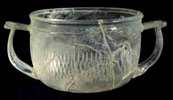 |
|
6795. LARGE ROMAN MARBLE HEAD, c. 1st Century AD. The over life-sized finely carved female head with ornate hair style drawn up in a bun behind. Sensitively modeled features with parted lips, thin diadem in hair. 9x12x12.5". 61 lb. Chip to nose but much more impressive than image shows. A fine example of classic sculpture from antiquity. On custom made base. Purchased from Sotheby's by the current owner. SOLD.
|
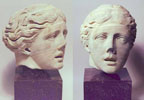 |
|
8293. LARGE PALMYRAN LIMESTONE HORSE AND RIDER. Roman Syria, c. 2nd century AD. Sizable limestone figure of horseman carrying a spear, he wears boots and a long robe fastened with a brooch at his neck. 6x12x13.5". 20 lbs. Rare. SOLD.
|
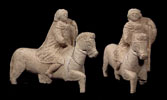 |
|
8294. LARGE PALMYRAN LIMESTONE HORSE AND RIDER. Roman Syria, c. 2nd century AD. Sizable limestone figure of horseman carrying a spear, he wears boots and a long robe fastened with a brooch at his neck. 6x10.5x13". 17 lbs. Rare. SOLD.
|
 |
|
7359. CLASSICAL ROMAN TERRA COTTA GLAZED OIL LAMP, c. 1st-2nd century AD. 3.25 inches. Tiny check at spout. SOLD.
|
 |
9709. ROMAN TERRA COTTA FIGURAL OIL LAMP, c. 1st-2nd century AD. The lamp with the high profile facing head of Mercury with wings on his head adorning the discus. 3.75 inches. Rare type.
SOLD.
|

|
9703. ROMAN TERRA COTTA FIGURAL OIL LAMP, c. 1st-2nd century AD. The lamp with a vine with grape bunch and two leaves on the discus. 3.8 inches. Maker's mark on bottom. Sharp excellent example.
SOLD.
|

|
|
6889. A ROMAN OIL LAMP, c. 1st-3rd century. The lamp with a seated griffin on the discus. 3.8". Intact. SOLD.
|
 |
|
6883. ROMAN BRONZE OIL LAMP, c. 3rd-5th century AD. With pedestal base and incised leaf handle. 5". Small cracks both sides but complete with original lid and nice patina. SOLD.
|
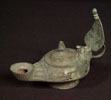 |
|
6884. A LATE ROMAN BRONZE OIL LAMP, c. 4th-5th c. Heavy construction with crescent handle and intact original animal head lid. 5.3". Couple of small holes on side. Better than image. SOLD.
|
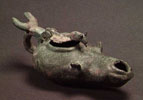 |
|
6886. A ROMAN BRONZE OIL LAMP, c. 3rd-4th century AD. With leaf handle and original shell-form lid. 4.8". Scarce. SOLD.
|
 |
|
6851. A ROMAN BRONZE OIL LAMP, about 2nd century. Uncleaned find condition. Complete, a small hole on top with deposits. Length is 9.5 cm. SOLD.
|
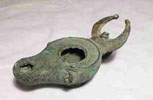 |
|
9327. ANTIQUARIAN EPICTETUS. EPICTETI ENCHIRIDIUM CEBETIS THEBANI TABULA, 1723. 1.5 x 5 x 8 inches. 288 pages. Engraved frontispiece and folding plate, engraved chapter headers and initials. Title page printed in red and black. Gold stamped vellum armorial binding. Sound and tight in generally nice condition, damp stains in lower corner throughout. Works by the famous Stoic philosopher Epictetus printed in Greek and Latin side by side.
SOLD.
|

|
|
6313. HIGH QUALITY CLASSICAL ROMAN BRONZE HERM, c. 1st-3rd century AD. The bronze herm of fine classical style with detailed features and hair and male genitalia with detailed pubic hair. 3 inches. Choice condition and patina. SOLD.
|
 |
|
11134. ROMAN LEGIONARY TILE, c. 1st century BC - 2nd century AD. No stamp but with the complete paw print of an ancient Roman dog no doubt attached to a Roman legion or perhaps a local pet. In any case the actual paw print of a dog that lived in ancient times preserved in time. 2.5 x 4 x 4.5 inches. SOLD.
| 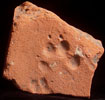 |
|
7253. A RARE HELLENISTIC EARLY ROMAN BALLISTA BOLT, 3rd-1st century BC. The bronze ballista bolt of large arrowhead form with tenon on trailing end. The Roman ballista was a large stationary crossbow that was mechanically wound up and shot bolts with tremendous force. It was the Roman equivalent of a small artillery piece. Very rare and in excellent condition. 3.75 inches. Dr Mike Bishop, co-author of 'Roman Military Equipment', suggests that this may be a rarer Hellenistic ballista bolt. SOLD.
|
 |
|
7255. A RARE HELLENISTIC / EARLY ROMAN BALLISTA BOLT, 3rd-1st century BC. The bronze ballista bolt of large arrowhead form with tenon on trailing end. The Roman ballista was a large stationary crossbow that was mechanically wound up and shot bolts with tremendous force. It was the Roman equivalent of a small artillery piece. Very rare and in excellent condition. 1.75 inches. Dr Mike Bishop, co-author of 'Roman Military Equipment', suggests that this may be a rarer Hellenistic ballista bolt. SOLD.
|
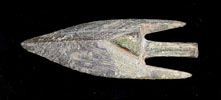 |
|
7256. A RARE HELLENISTIC EARLY ROMAN BALLISTA BOLT, 3rd-1st century BC. The bronze ballista bolt of large arrowhead form with tenon on trailing end. The Roman ballista was a large stationary crossbow that was mechanically wound up and shot bolts with tremendous force. It was the Roman equivalent of a small artillery piece. Very rare and in excellent condition. 3 inches. Dr Mike Bishop, co-author of 'Roman Military Equipment', suggests that this may be a rarer Hellenistic ballista bolt. SOLD.
|
 |
|
6853. A RARE ROMAN EMERALD INTAGLIO, c. 1st-3rd cent. Carved with a standing male figure holding a scepter. 12mm. Emeralds were imported to Rome from India but such intaglios are extremely rare. SOLD.
|
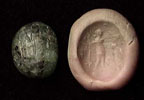 |
|
6864. A ROMAN GLASS FLASK WITH MOLDED HEADS, c. 2nd-3rd century AD. The yellow green glass perfume bottle with molded female faces with curled hair both sides. 3.1 inches. Professional repair. On custom stand. Rare. SOLD.
|
 |
|
6874. ROMAN GLASS SPRINKLER FLASK, c. 1st-3rd century AD. The bottle with globular base with molded honeycomb pattern, the original neck made separately and attached when the glass was hot to form a narrow passage within the neck to facilitate sprinkling small amounts of contents such as perfume. 2.6 inches. Excellent intact condition and considerably nicer than photo. SOLD.
|
 |
|
6358. Roman jug, early IV c, 7.4". SOLD.
|
 |
|
6360. Roman jar, IV c, mold-blown, 4.6" x 3.2". SOLD.
|
 |
|
8310. A LARGE ROMAN IRON BORER OR FILE, c. 1st-3rd century. The tool with indent one end for attaching handle. 7". Cf. Petrie, 'Tools and Weapons', plate LXV, #40. SOLD.
|
 |
|
THE EMPEROR MARCUS AURELIUS
7216. A FINE ROMAN INTAGLIO IMPRESSION OF MARCUS AURELIUS, c. 2nd century AD. Fired clay stamped with right facing head of the Roman emperor Marcus Aurelius. 17mm. SOLD.
|
 |
|
7105. A ROMAN ARCHAIZING HEAD OF DIONYSUS, c. 1st-2nd century AD. The god depicted with garlanded hair and long spade beard. 2 x 2.5 inches. On custom oak stand. From the collection of an American artist living in Rome during the early 20th century. SOLD.
|
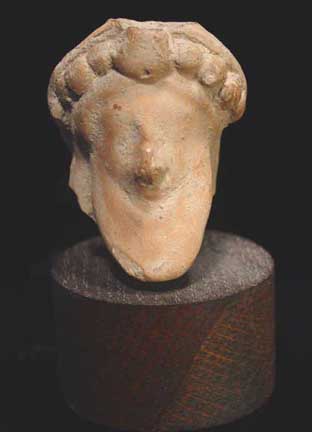 |
|
8708. A ROMAN TERRA COTTA HERM, c. 1st-3rd century. The figure with typical stub arms and erect male organ. 4.8". Chip to back of head. Rare terra cotta example. SOLD. |
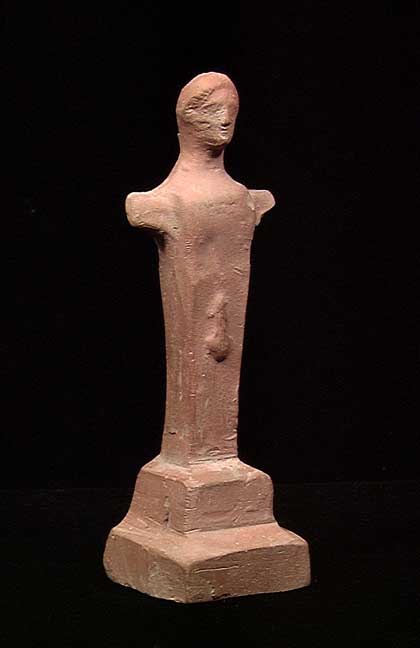 |
|
7252. A FINE ROMAN BRONZE BOY, c. 1st-2nd century AD. The small but very finely detailed boy striding in an animated posture with r. hand raised, he is nude except for a chlymas draped over his shoulder and around his pubic area. 30 mm. This type of fine small figures ornamented the top of fine cloak and hair pins worn by sophisticated ladies. SOLD.
|
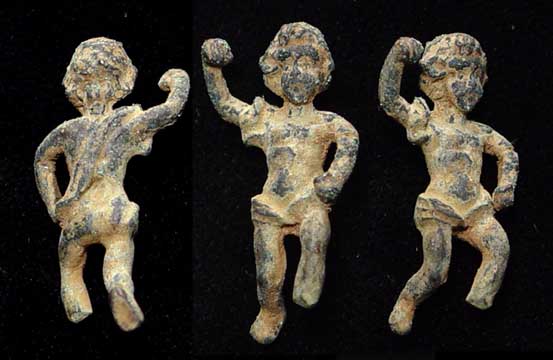 |
|
7649. ROMAN BRONZE ACTOR'S MASK, c. 1st-2nd century AD. Exceptional depiction of the classical actor's mask. 2 x 2.5 inches. SOLD.
|
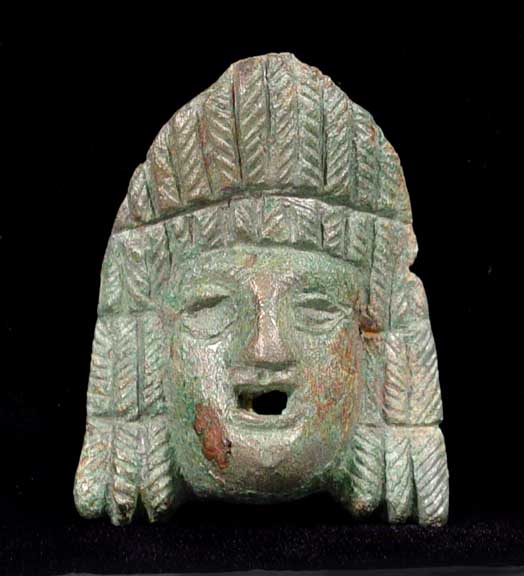 |
|
7650. FINE ROMAN BRONZE HEAD OF SILENUS, c. 1st-2nd century AD. The satyr with long beard and mustache and goat ears, a vine wreath on his bald head. 3.5 cm. Fine classical style. SOLD.
|
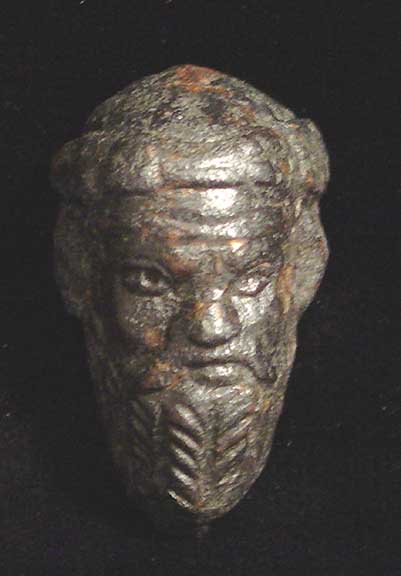 |
|
8143. ROMAN BRONZE CENTAUR LIKELY A LORICA SQUAMATA LEGIONARY ARMOR PLATE. c. 1st-3rd century AD. The sheet bronze hammered from behind in repousse technique to raise the figure of a centaur holding a bow. Likely used in some legionary application most likely as a lorica squamata legionary armor plate segment. 1.75 x 1.75 inches. Remains of two rivet holes where it was attached, tear on body. Rare and interesting. SOLD.
|
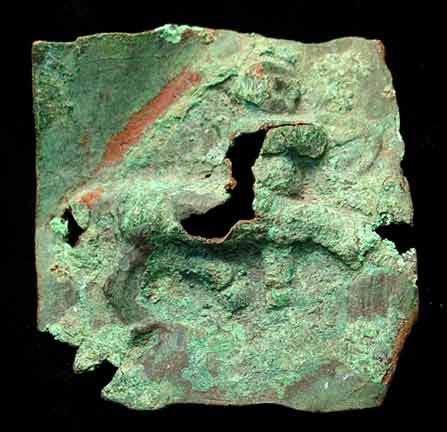 |
9073. A ROMAN BRONZE EQUINE FOREHEAD PLATE, c. 1st-3rd century AD. The circular equestrian disk with knobbed ornament, two attachment loops at the sides, the type worn over the forehead of a Roman legionary cavalryman's mount. 3.75 inches. Excellent condition and rare.
SOLD.
|
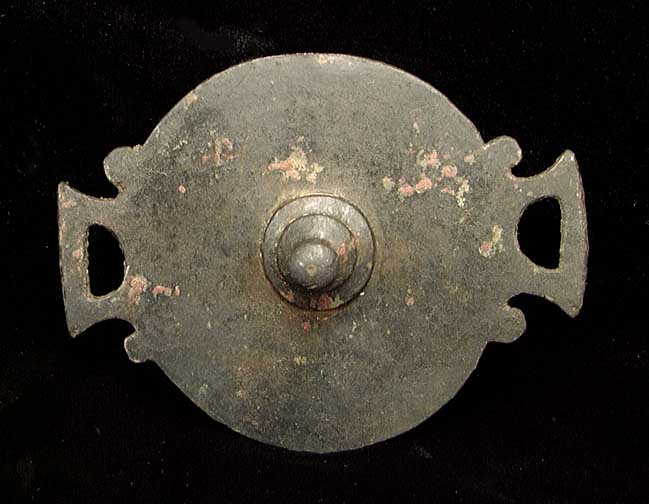
|
|
7254. A RARE HELLENISTIC EARLY ROMAN BALLISTA BOLT, 3rd-1st century BC. The bronze ballista bolt of large arrowhead form with tenon on trailing end. The Roman ballista was a large stationary crossbow that was mechanically wound up and shot bolts with tremendous force. It was the Roman equivalent of a small artillery piece. Very rare and in excellent condition. 3.3 inches. Dr Mike Bishop, co-author of 'Roman Military Equipment', suggests that this may be a rarer Hellenistic ballista bolt. SOLD.
|
 |
|
6446. ROMAN GOLD RING WITH CABOCHON GARNET SETTING, c. 1st-3rd century AD. The band of hollow sheet gold over frit, a cabachon garnet set in the bezel. 23 mm, 16 x 18 mm internal. Minute crack inside bottom of band and small press mark one side but wearable with care. US size 6.6. SOLD.
| 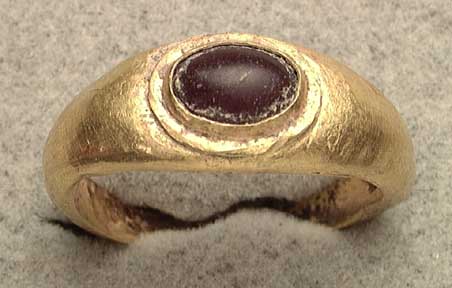 |
|
12874. ROMAN GOLD CAMEO RING 1ST CENTURY AD
15mm x 17mm inner diameter. Wearable with care.
Weight 2.54 grams.
Provenance: Ex London UK private collection, purchased in 1993 from an antiquities dealer in London.. Another view. Side view. SOLD. |
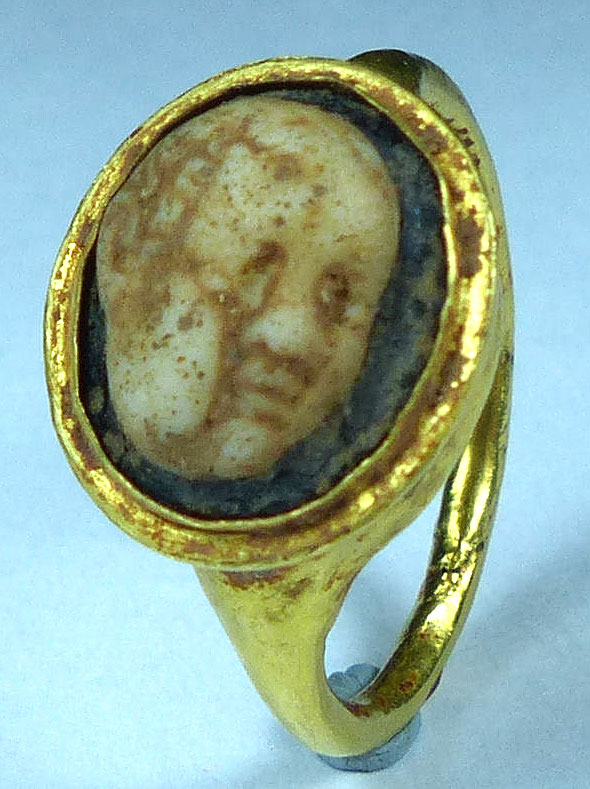 |
|
6856. LARGER ROMAN GLASS BOTTLE, c. 1st-3rd century. With globular body original trimmed rim. Three faint wheel cut bands on the pinched neck. Intact with light iridescence. 4.4 x 5.75". SOLD.
|
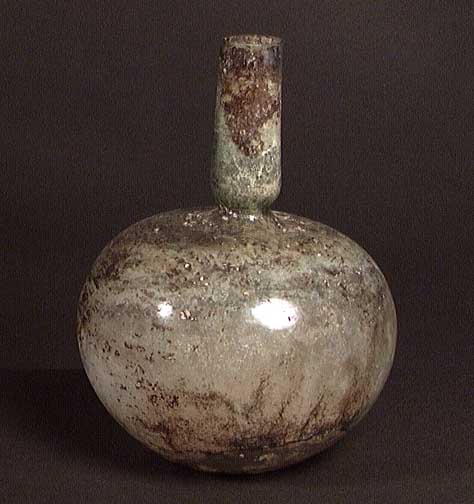 |
|
11642. BEAUTIFUL ROMAN GEOMETRIC MOSAIC. 2nd century AD. 96 x 186 cm. Excellent condition. Provenance: Good and legal provenance provided to buyer. SOLD. |
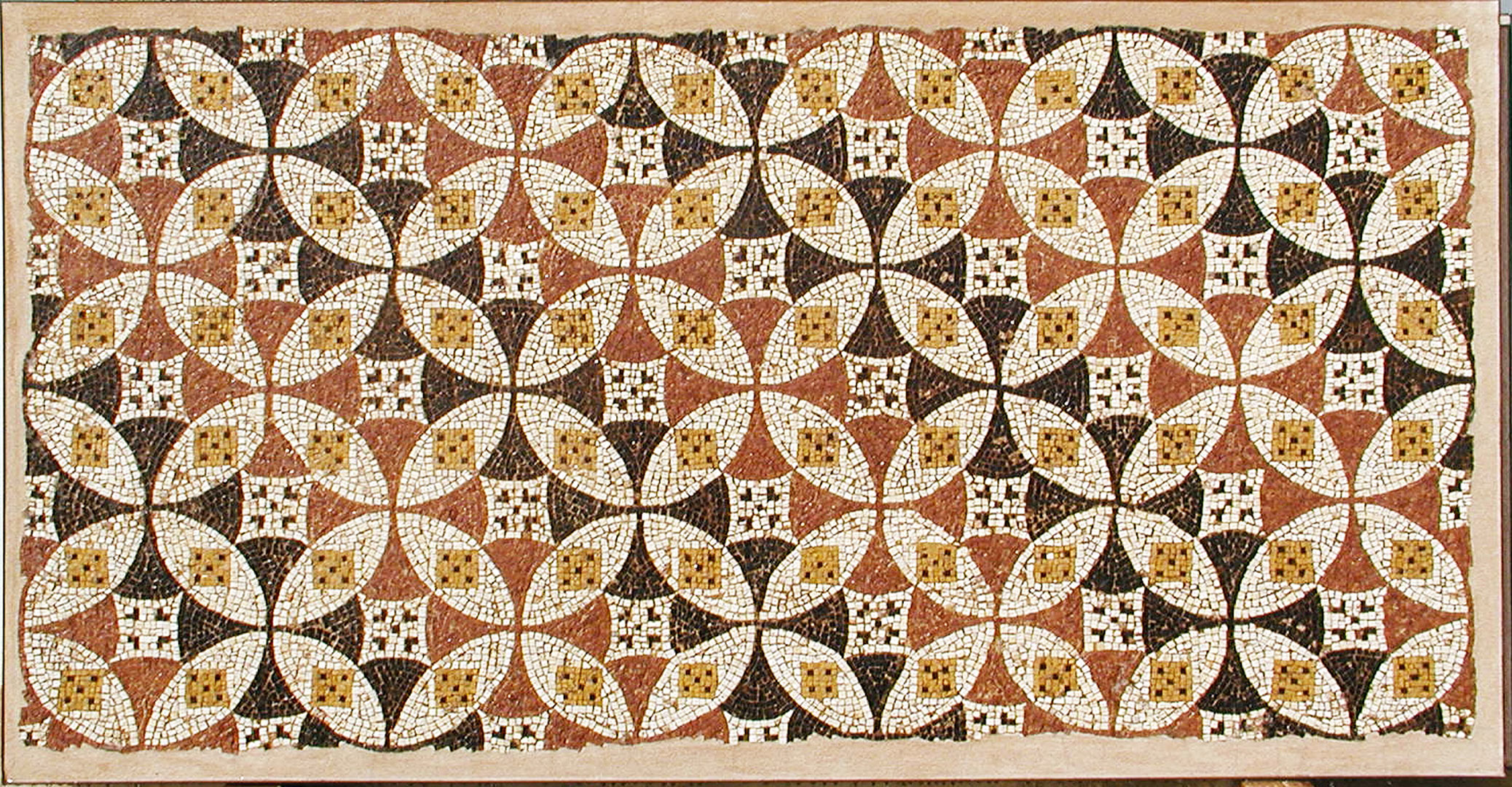
|
|
7356. ROMAN TERRA COTTA OIL LAMP WITH DIANA, c. 1st-2nd century AD. The lamp with figure of the goddess Diana loosing an arrow. 4.25 inches. Handle restored. SOLD.
|
 |
|
7357. A ROMAN OIL LAMP DEPICTING THE YOUTH GANYMEDE BEING CARRIED AWAY BY ZEUS IN THE GUISE OF AN EAGLE, c. 1st-2nd century AD. The clay oil lamp with the beautiful youth Ganymede being abducted by Zeus who having become enamored with him assumed the form of an eagle and carried him away. Zeus's loves, seductions and rapes are a central part of Greek myth and he had both heterosexual dalliances with maidens and homosexual encounters with youths alike. 3.25 inches. Handle restored somewhat obscuring Ganymede's head which is likely present beneath, otherwise in excellent condition. Somewhat clearer than photo. A rare mythological depiction. SOLD.
|
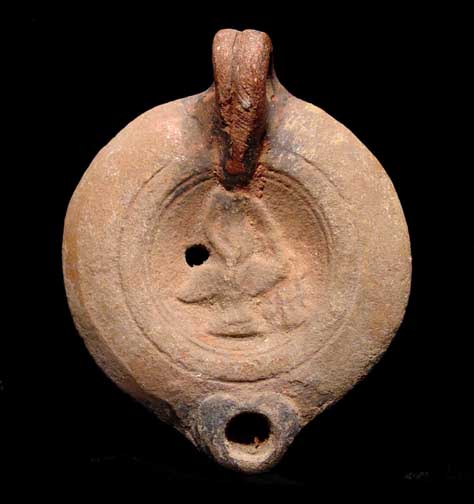 |
|
7358. ROMAN TERRA COTTA OIL LAMP, c. 1st-2nd century AD. With large floral design on the discus. 3.5 inches. Abrasion to wick hole but sharp design. SOLD.
|
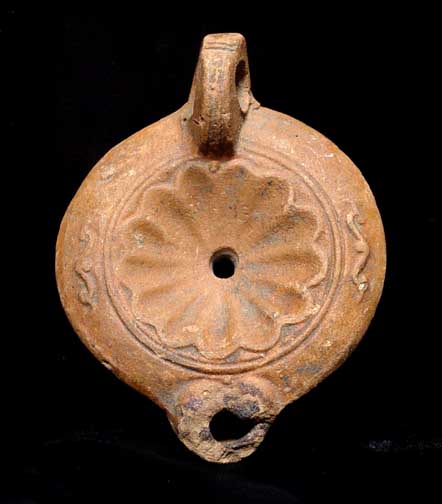 |
|
7237. ROMAN SMALL BRONZE OIL LAMP, c. 1st-2nd century AD. The lamp on high base with two nozzles, the handle in the form of a ram's head, the body ornamented with a raised pearl pattern, a small loop between the nozzles. 2.5 x 1.5 inches. SOLD.
|
 |
|
7610. ROMAN BRONZE LAMP, of the 1st century. Typical early classical shape. The lamp is complete with the lid and the lid chain. Nice ornamented handle. 12 x 6 cm. Intact and rare lamp. SOLD.
|
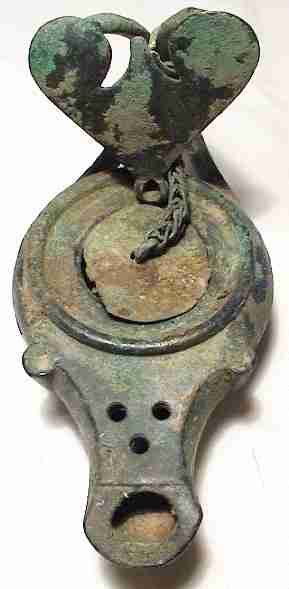 |
|
6837. A ROMAN OIL LAMP, about 2nd century AC. Open form made of brown glazed clay. Typical work from the roman Rhineland. Found in Cologne. Intact. Length is 11 cm. SOLD.
|
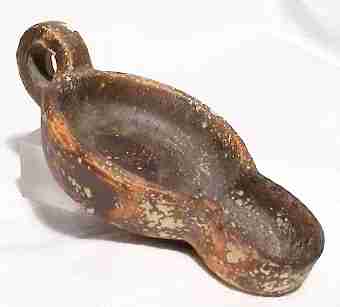 |
|
6825. A ROMAN OIL LAMP in shape of a face. About 3rd century. The handle is in shape of a leaf, the face shows a bearded man. Fully intact. The length is 15.5 cm. Rare and nice. SOLD.
|
 |
|
6823. A ROMAN OIL-LAMP, about 3rd century. Peach shaped body, long spout. Rare type. Found in Trier. Length is 8.5 cm. Intact. SOLD.
|
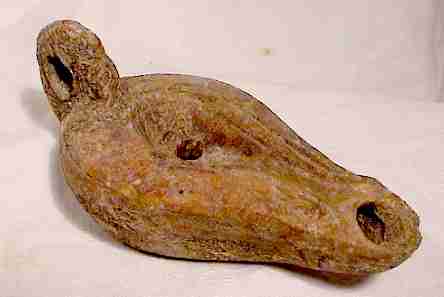 |
|
6345. Roman oil-lamp, III-IV c, 2.4"x 1.6". SOLD.
|
 |
|
6808. 3 Roman oil-lamps, IV-V c AD, up to L 3.6" . SOLD.
|
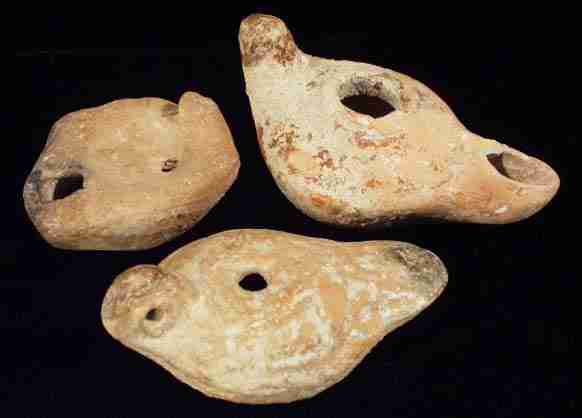 |
|
6888. ROMAN FIGURAL OIL LAMP, c. 1st century AD. The lamp in the form of a reclining nude male figure wearing an oriental cap, perhaps a Nubian. The figure holds a woven basket which serves as the filler hole. 6.2 inches. Rare! SOLD.
|
 |
|
7451. ROMAN FINE WARE BOWL. c. 1st-3rd century AD. Thin walled red glazed Roman fine ware bowl With two incised marks on the base rim, probably an owner's mark. 2.25 x 4 inches. Intact but for a couple of inconsequential flakes on the rim. SOLD.
|
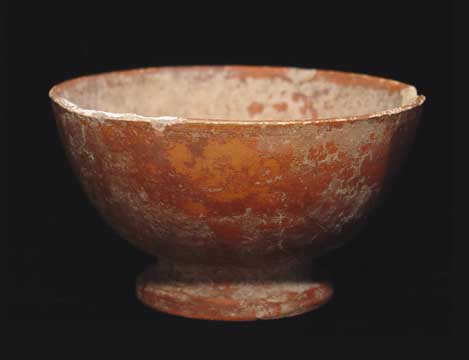 |
|
8721. HEAVY BRONZE ROMAN PATERA HANDLE, c. 1st-3rd century AD. The heavy fluted handle terminating in a collar from which emerges a ram's head with curled horns. 5.6". The patera was used to make sacrificial offerings to the Gods. Rare. Strong intact condition. SOLD. |
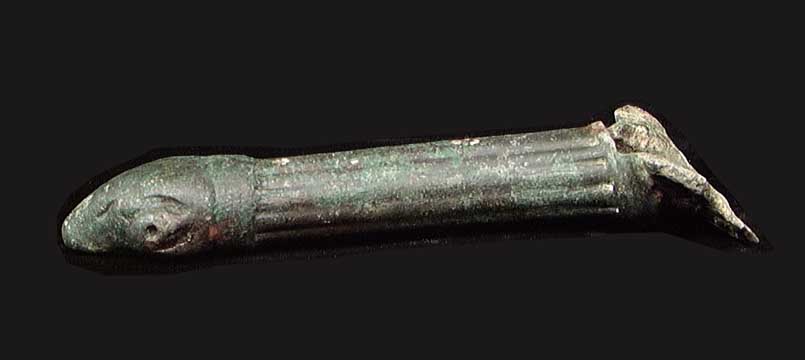 |
|
8707. A LARGE ROMAN TERRA COTTA BUST, c. 2nd-4th century. The red ware bust of a lady molded on integral socle. Covered with remains of white slip and light encrustation. 7.3" x 13.7". Intact. SOLD. |
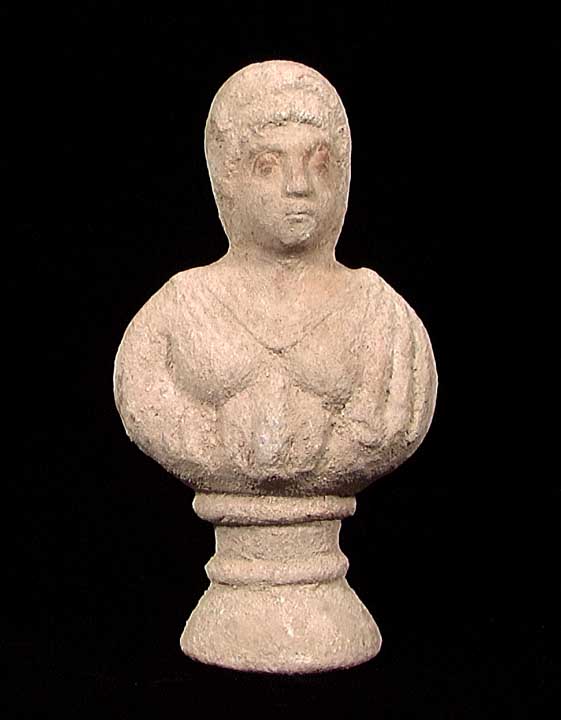 |
9748. LATE ROMAN BRONZE HANDLE WITH BARBARIAN INFLUENCE, c. 4th-5th century AD. The terminus in the form of a bird with detail on both sides. The style with central European influence, perhaps Gaul, Goth or Germanic. 1.7 inches. Nice.
SOLD.
|
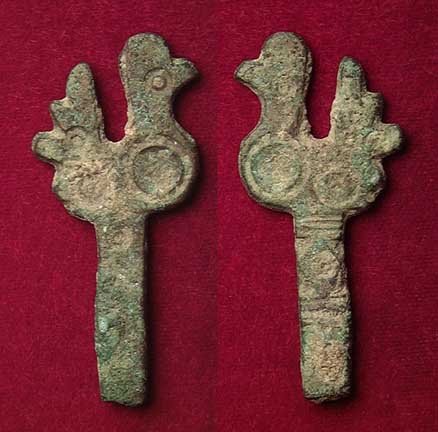
|
9738. A ROMAN BRONZE STATUETTE OF A GODDESS, c. 1st-3rd century AD. The figure likely that of Tyche/Fortuna as she holds a cornucopia. Solid cast with detail both sides, especially nice on reverse and considerably better than image. 2.8 inches.
SOLD.
|

|
|
8298. A ROMAN BRONZE LION HEAD BOSS, c. 1st-3rd century. Nice larger example with tufted beard. 2". Excellent condition. SOLD.
|
 |
|
8299. A ROMAN BRONZE LION HEAD BOSS, c. 1st-3rd century. Nicely cast with green black patina. 1.6" diameter. SOLD.
|
 |
|
11184. SMALL ROMAN BONE OR IVORY DICE. 1st-3rd century AD. From 0.6-0.9cm. diameter. One cracked, otherwise good condition. One dice only, the top row number 1 from left. SOLD.
| 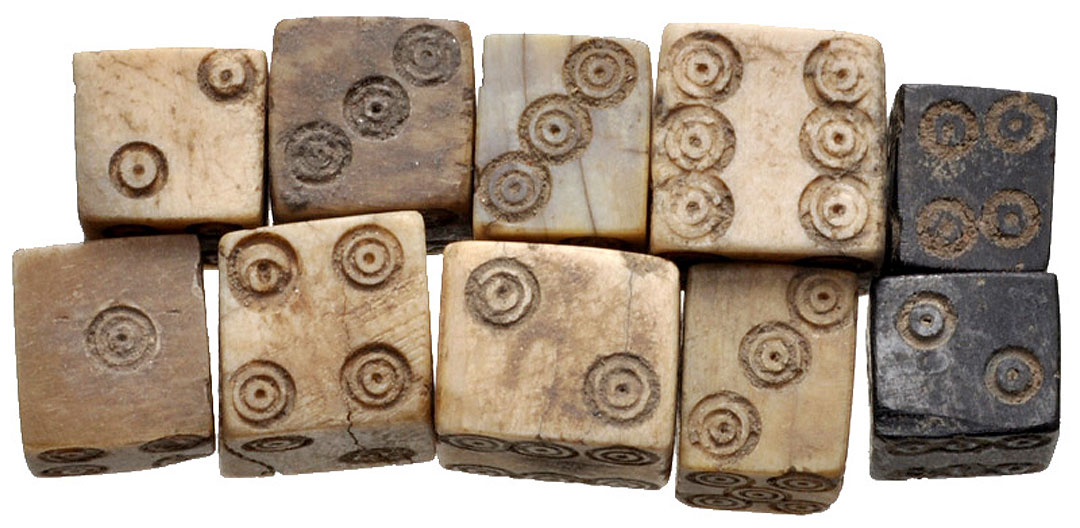 |
|
11185. SMALL ROMAN BONE OR IVORY DICE. 1st-3rd century AD. From 0.6-0.9cm. diameter. One cracked, otherwise good condition. One dice only, the top row number 2 from left. SOLD.
|  |
|
11186. SMALL ROMAN BONE OR IVORY DICE. 1st-3rd century AD. From 0.6-0.9cm. diameter. One cracked, otherwise good condition. One dice only, the top row number 3 from left. SOLD.
|  |
|
11187. SMALL ROMAN BONE OR IVORY DICE. 1st-3rd century AD. From 0.6-0.9cm. diameter. One cracked, otherwise good condition. One dice only, the top row number 4 from left. SOLD.
|  |
|
11188. SMALL ROMAN BONE OR IVORY DICE. 1st-3rd century AD. From 0.6-0.9cm. diameter. One cracked, otherwise good condition. One dice only, the top row number 5 from left. SOLD.
|  |
|
11189. SMALL ROMAN BONE OR IVORY DICE. 1st-3rd century AD. From 0.6-0.9cm. diameter. One cracked, otherwise good condition. One dice only, the bottom row number 1 from left. SOLD.
|  |
|
11190. SMALL ROMAN BONE OR IVORY DICE. 1st-3rd century AD. From 0.6-0.9cm. diameter. One cracked, otherwise good condition. One dice only, the bottom row number 2 from left. SOLD.
|  |
|
11191. SMALL ROMAN BONE OR IVORY DICE. 1st-3rd century AD. From 0.6-0.9cm. diameter. One cracked, otherwise good condition. One dice only, the bottom row number 3 from left. SOLD.
|  |
|
11192. SMALL ROMAN BONE OR IVORY DICE. 1st-3rd century AD. From 0.6-0.9cm. diameter. One cracked, otherwise good condition. One dice only, the bottom row number 4 from left. SOLD.
|  |
|
11193. SMALL ROMAN BONE OR IVORY DICE. 1st-3rd century AD. From 0.6-0.9cm. diameter. One cracked, otherwise good condition. One dice only, the bottom row number 5 from left. SOLD.
|  |
9749. A LATE ROMAN BRONZE BROOCH, c. 3rd-5th century. In the form of a horse. 1.25 inches.
SOLD.
|
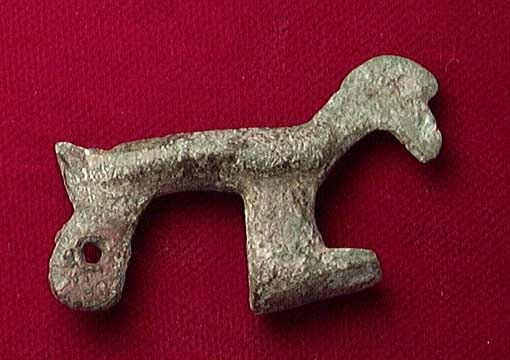
|
|
7260. ROMAN BYZANTINE THIMBLE, c. 4th-8th century AD. For sewing. 0.8 inches. Scarce. SOLD.
|
 |
|
8142. FINE ROMAN BRONZE FIBULA IN THE FORM OF A BEE, c. 2nd-3rd century AD. A small garnet still intact in one of the eyes, a larger setting on the back empty. Remains of iron post on the back. Very rare and interesting type. SOLD.
|
 |
|
11047. GRAECO ROMAN SHIP MOSAIC, circa. Eastern Mediterranean, c. 1st century BC - AD. The mosaic depicting two soldiers on the deck of a ship with 10 oars and two steering oars with a cabin at the back. It appears to be a military ship with a ram and the soldiers appear to be wearing swords. Mounted on a high tech space age super strong honeycomb backing which is much lighter, easier to handle and stronger than the traditional cement backing. Likely some minor repair which is almost always the case with ancient mosaics. 26 x 38 x 1 inch. 40 lbs. Two mounting brackets embedded in the reverse. Rare and a nice example with an interesting motif. Upper left corner is slightly in shadow in photo. In life it's the same as the rest of the mosaic. SOLD.
|  |
|
11162. GROUP OF 10 STYLII FROM A GRAECO ROMAN SCHOOL, c. Hellenistic-3rd century AD. The ten bronze stylii of identical form found together in the ruins of what was most likely a Roman period school, academy or scriveners establishment. The bronze stylus was used for writing on wax over wood tablets. The tablets could be erased and reused by remelting and smoothing the wax surface. Said to have been found near Nikopolis in Asia Minor. Length is a little over 6 inches. In nice condition. Rare to find a group like this. Better than photo.
| 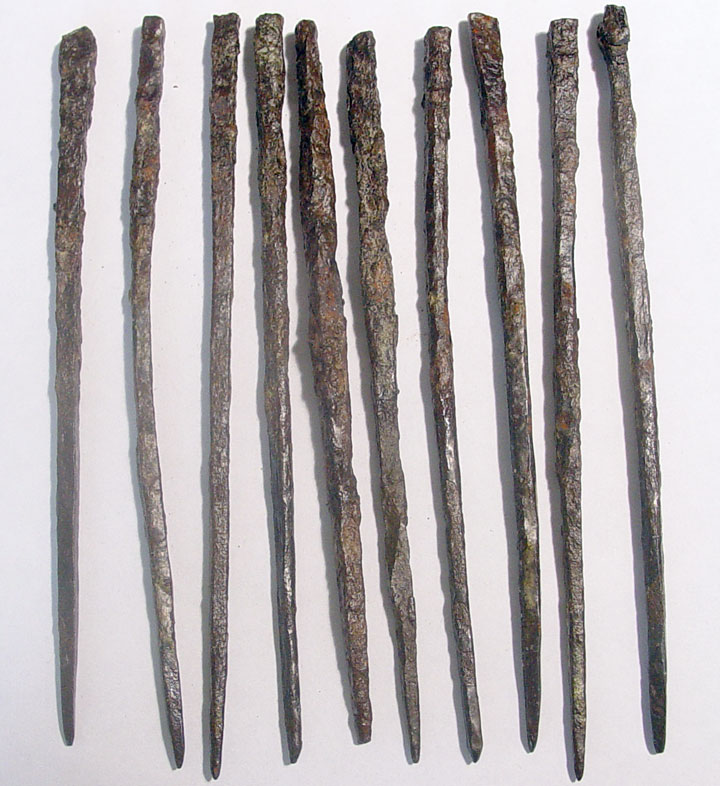 |
SOLD.
|
11046. GROUP OF 5 STYLII FROM A GRAECO ROMAN SCHOOL, c. Hellenistic-3rd century AD. The five bronze stylii of identical form found together in the ruins of what was most likely a Roman period school, academy or scriveners establishment. The bronze stylus was used for writing on wax over wood tablets. The tablets could be erased and reused by remelting and smoothing the wax surface. Said to have been found near Nikopolis in Asia Minor. Length is a little over 6 inches. In nice condition. Rare to find a group like this. Better than photo.
|  |
SOLD.
|
6454. Gold eye-plates, I-II c AD, Roman provincial, East. Mediterranean, incised lines showing pupil, iris, lashes. L 5.6".
|
 |
SOLD.
|
6455. Gold eye-plates and mouth plate, I-II c AD, Roman provincial, East. Mediterranean, L 6.3" for eye-plates.
|
 |
SOLD.
|
6456. Roman gold wreath, I c BC- I c. AD, up to 2.3".
|
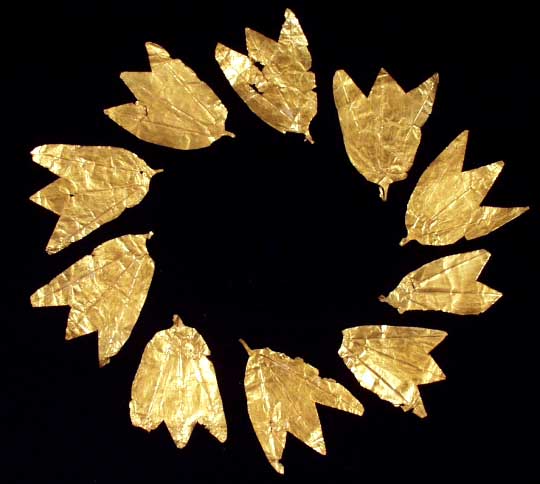 |
SOLD.
|
6461. 2 ROMAN GOLD PENDANTS WITH SETTINGS, ca. 1st-3rd century. The first with an aquamarine colored natural crystal of semi-precious gemstone, the second with a blue glass bead. To 29mm. Very fine workmanship with granulation around. Great dealer or jeweler's lot.
|
 |
SOLD.
|
6314. CHOICE CONDITION ROMAN BRONZE HERM, c. 1st-3rd century AD. The bronze herm of provincial style with sharp features and detailed curly hair (most on sides not visible in photo), holes for copper inlaid nipples now missing and crisp male genitalia. 2.7 inches. Choice condition and patina.
|
 |
SOLD.
|
6357. Roman bowl, I-early II c, 5.1 x 2.4".
|
 |
SOLD.
|
6374. Roman bronze & carnelian ring, male head left in Helios crown, III c, 20 x 18 mm.
|
 |
SOLD.
|
6375. Roman bronze & convex garnet ring, Athena left, I c, 24 x 21 mm.
|
 |
SOLD.
|
6891. A ROMAN BRONZE BOWL, ca. 1st-3rd century. Hemispheric bowl with incised bands on exterior rim. 4.7". Excellent condition with green & redish patina.
|
 |
SOLD.
|
6892. A CHOICE ROMAN SLING BULLET, ca. 1st-3rd century AD. With a sharply molded spear head on one side. 1.2".
|
 |
SOLD.
|
6798. 2 CHOICE ROMAN MEDICAL INSTRUMENTS, c. 1st-2nd century AD. Both from the same matching set. To 6.75 inches. Choice condition and rare! The lower one is a spoon-like object which does not show well in the image.
|
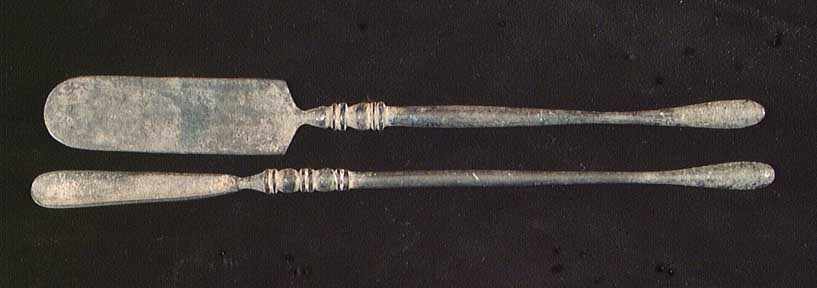 |
SOLD.
|
6799. A CHOICE ROMAN BRONZE SWASTICA BROOCH, ca. 3rd-4th century AD. With engraved linear design. 1.1". Complete with original pin. Traces of tinning on the surface. Choice example.
|
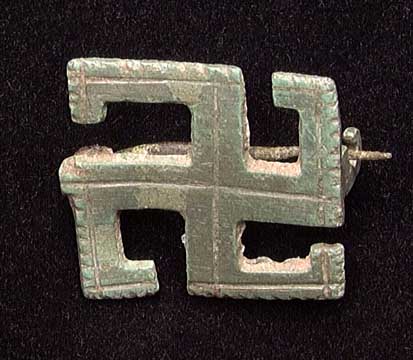 |
SOLD.
|
6858. A ROMAN MOLDED GLASS HEAD. Syria or Holy Land, ca. 1st-3rd century. The nicely style curly haired male head molded of opaque black glass with blue beard. Perhaps the head of Hercules or a boxer by the robust style. 25mm. Rare & nice.
|
 |
SOLD.
|
6859. A ROMAN MOLDED GLASS HEAD. Syria or Holy Land, ca. 1st-3rd century. The curly haired male head, likely a young Nubian slave, molded of opaque black glass. 25mm. Rare & nice.
|
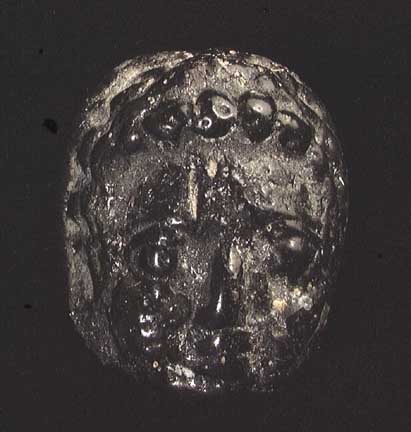 |
SOLD.
|
6863. A FINE ROMAN GLASS BOTTLE, ca. 2nd-3rd century AD. The yellow green glass bottle with strands of applied glass rigaree from rim to shoulders. 2.9 x 3 inches. Professional repair. Rare.
|
 |
SOLD.
|
6865. A ROMAN GLASS 'DATE FLASK', ca. 2nd-3rd century AD. The amber glass perfume bottle in the form of a date with wrinkled skin. 2.6 inches. Professional repair. On custom stand. Rare.
|
 |
SOLD.
|
6867. A ROMAN RIBBED GLASS BOWL, ca. 2nd-4th century. The thick aubergine glass vessel with 20 molded vertical ribs. 2.5 x 5.25 inches. Repair. Very rare. On custom lucite stand.
|
 |
SOLD.
|
6809. Roman amphora, end of II- III c AD, H 20.1", repaired from large shards.
|
 |
SOLD.
|
6810. Roman Terra Sigillata, I c. AD, two-handled cup with barbotine decoration, cracked,but intact, H 3.3".
|
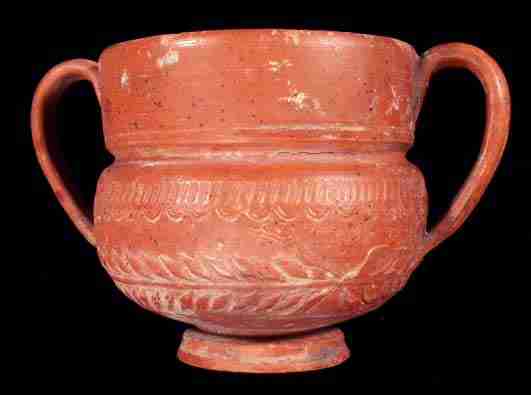 |
SOLD.
|
6811. Roman Terra Sigillata, sec. half of I -III c. AD, two-handled cup with barbotine decoration, mended, H 2.9".
|
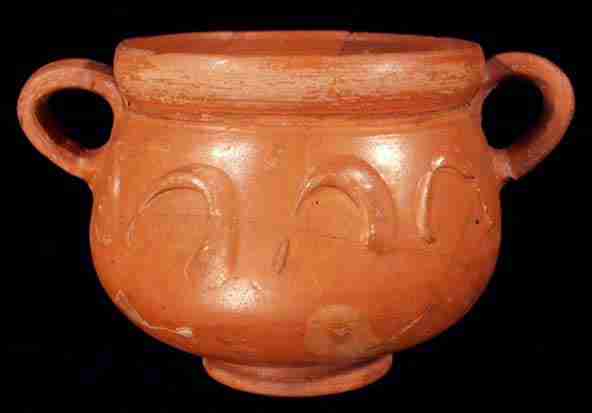 |
SOLD.
|
6812. Roman Terra Sigillata, sec. half of I -III c. AD, two-handled cup with barbotine decoration, mended, H 2.4".
|
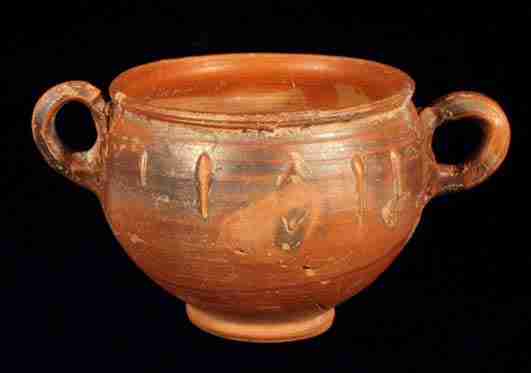 |
SOLD.
|
6814. Roman glass jug, East. Mediterranean, II c AD, intact, H 5.1".
|
 |
SOLD.
|
6815. Roman glass jug, East. Mediterranean, II c AD, intact, H 7.3".
|
 |
SOLD.
|
6827. A ROMAN DICE, made of bone. Dark brown color. The length is 1.4 cm Intact. Large example.
|
 |
SOLD.
|
6832. A ROMAN LEGIONARY TILE, Legio XXII. The inscription reads LEG XXII P PF (Legion 22 Primigenia Pia Fidelis). The Legio XXII was founded by Caligula in the year 39 AC. The first base was in Mogontiacum (Mainz). In the year 71 the legio was shifted to Vetera (Xanten). Here the legio was stationed until the fall of the roman empire in the late 4th century. The legio XXII was one of the famous “Rhine Legions”. Under Domitian the XXII was honoured by him with the title “Pia Fidelis”.
A wonderful clear stamp on a bright red tile. Size is 15 cm x 10 cm.
|
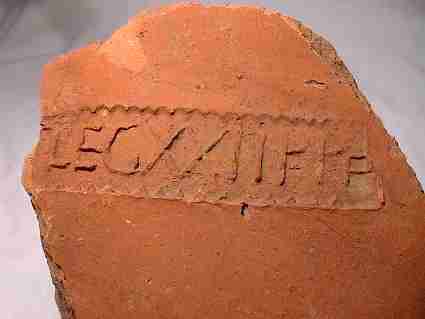 |
SOLD.
|
6833. A ROMAN LEGIONARY TILE, Legio V Macedonia. The inscription reads LVM (Legio V Macedonia).The Legio V M was founded in the early 1st century and was stationed in Macedonia. Shortly after foundation the legio was moved to Moesia. In the year 62 it was transferred to Armenia. Legio V M has been involved in the Judean war in 70/71 under Vespasian. After this war the base was again in Moesia. Afterwards the legio takes part in the Dacian wars and was stationed there. From 274 AC until the end of the roman empire the base was again in Moesia . Size is 20 cm x 20 cm. A rare legionary stamp on a massive tile.
|
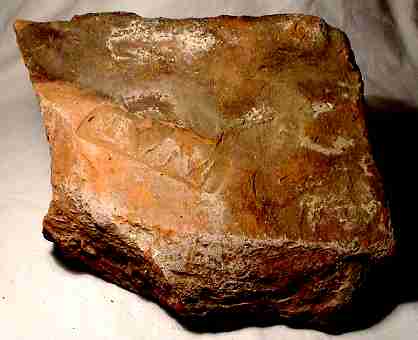 |
SOLD.
|
6834. A ROMAN WATER SUPPLY TILE, made of bright clay. At the rear and the front chalk encrustations from the water which had run through. Found in Cologne. A shard at the rear is repaired. Otherwise complete and rare item. Length is 58 cm, diameter is 11 cm.
|
 |
SOLD.
|
6836. A ROMAN LEGIONARY SHOE SOLE found in the river Mosel near Trier. Good preservation through the fact the sole was hermetical closed in the mud. Also one of the iron nails is preserved. Very rare item! Length is 10 cm.
|
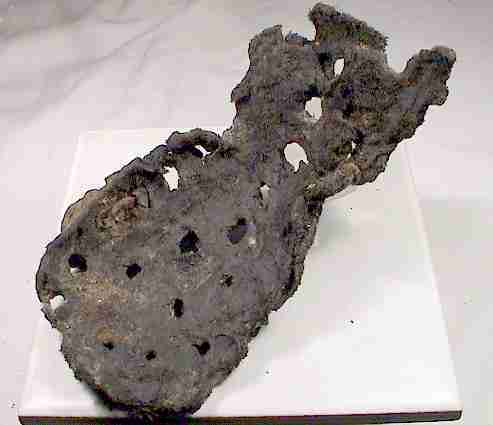 |
SOLD.
|
6841. VERY LARGE ROMAN BALSAMARIUM in a rare and interesting shape. Made of light greenish glass. Long neck with bulbous body and again a long end. The overall length is 30 cm! A similar but smaller glass was found in Trier. This one comes from the Cologne area. Perfect condition with no cracks or chips.
|
 |
SOLD.
|
6842. ROMAN BEAKER with a nice decoration. About 3rd century. Brown glazed clay. Typical work from the roman rhineland. Found in Cologne. Height is 8.5 cm. A stable crack at one side but no repairs.
|
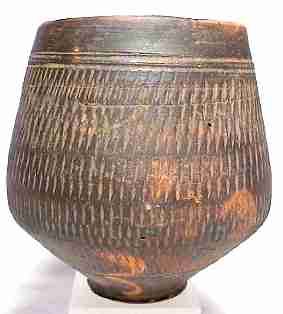 |
SOLD.
|
6843. ROMAN COMB, about 4th century. Made of bone in the shape of a fish with two heads. Found in the Trier area. Broken in the middle. Length is 14 cm. Rare item of roman daily life.
|
 |
SOLD.
|
6844. A VERY RARE ROMAN PILE SHOE , about 2nd century AC. In this the wooden bridge piles were rammed into the ground of the river to preserve the wood and to get a better hold in the ground. This pile shoe was found in the river Mosel near the center of Trier in 1957. One of the legs broken and missing. One of the original large nails is still preserved. A very good solid condition. A extremely rare item. Length is 60 cm.
|
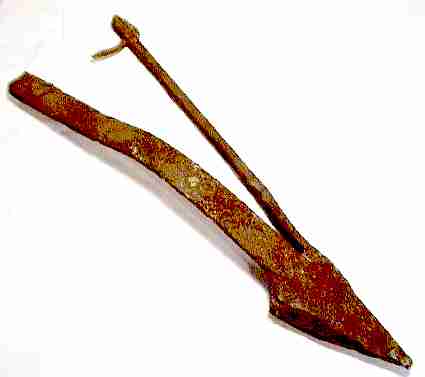 |
SOLD.
|
6845. A ROMAN BODY ARMOUR ORNAMENT, showing Hercules. A very nice and detailed work which shows that this was part of an officers body armour. Hercules standing frontal with his face worked in a half-relief. The face shows much detail like the hairs and the beard. He his holding his attributes: the club and the lion skin. The height of the sheet is 10 cm. Green patina. Uncleaned find condition. Classical Roman style.
|
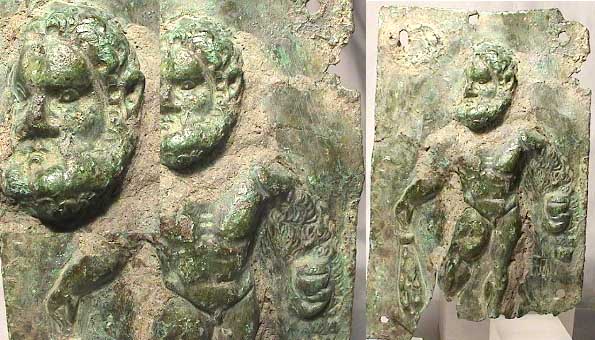 |
SOLD.
|
6846. A ROMAN SCALE, about 2nd century AC. Found in Trier. Nice green and even patina, moveable. Length is 24 cm.
|
 |
SOLD.
|
6848. ROMAN SPOON, about 2nd century. Made of bronze with a nice green patina and an ornamented handle. Completely intact. A very nice classical Roman spoon. Length is 13 cm.
|
 |
SOLD.
|
7372. ROMAN TERRA COTTA FIGURE OF A DOVE. c. 1st-3rd century AD. The dove with spread wings (chip to one). 3.25 inches.
|
 |
SOLD.
|
7261. ROMAN BYZANTINE THIMBLE, c. 4th-8th century AD. For sewing. 0.8 inches. Scarce.
|
 |
SOLD.
|
7536. CHOICE ANCIENT BEAD NECKLACE, 3rd century BC-1st millennium AD. The necklace with 53 ancient mostly mosaic glass beads, most Roman a few a little later. Necklace 31 inches, longest bead is Phoenician 2.2 inches. Nice selection of better mosaic glass beads.
|
 |
SOLD.
|
7211. A LARGE ROMAN APPLICAE, 1st-3rd century AD. The bronze applicae with a facing head, remains of four mounting tenons on rv. 3.1 inches diameter.
|
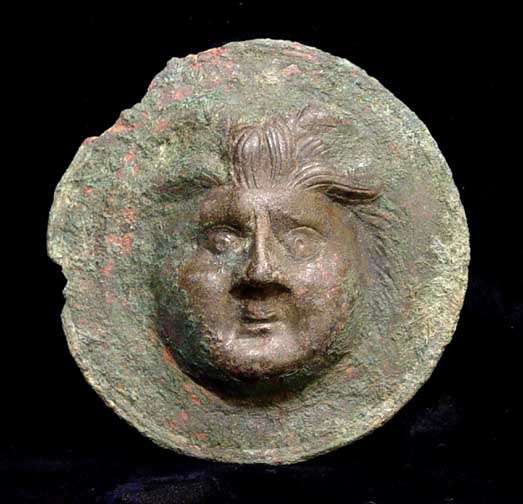 |
SOLD.
|
7606. ROMAN LEGIONARY TILE, Fleet troup, Cologne, dates after 89 AD. The name of the fleet troups, stationed in Cologne, was CLASSIS AUGUSTA GERMANICA. This fleet was founded by Drusus. Main harbour was Cologne (Castell Cologne-Altenburg). In 89 AD the fleet was honored by Domitian and got the name PIA FIDELIS like the Legion XXII. The main service was patroling on the Rhine and later to transport goods for the Legions. Inscription: CG PF (Classis Germanica Pia Fidelis), 12 x 10 cm large fragment, very rare Legion tile, Reference:Passauer Universität, Schriften zur Archäologien, Volume 6.
|
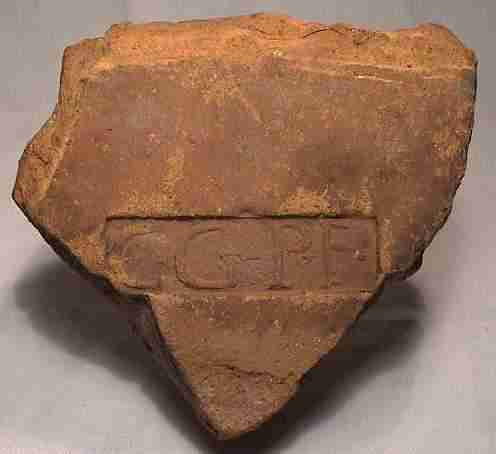 |
SOLD.
|
7607. ROMAN LEGIONARY TILE, Cologne This very rare tile stamp was issued by a tile production site under the command of the “EXERCITUS GERMANIEA INFERIORIS”, wich means armies of the provinc Germnia inferior.
The exact site can not be determinated, but was located somewhere on the lower Rhine.
Inscription: EX GR INF, 10 x 6 cm large fragment, very rare Legion tile, Reference:Passauer Universität, Schriften zur Archäologien, Volume 6.
|
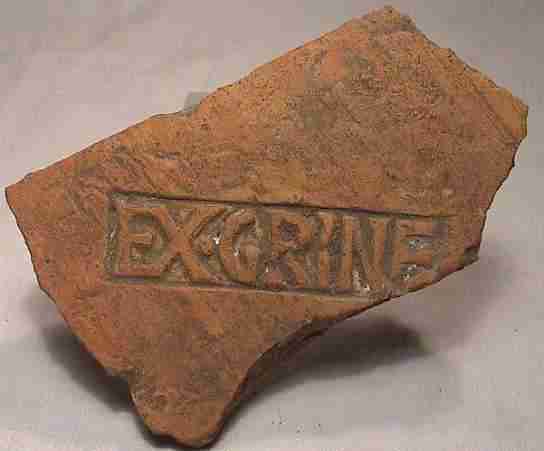 |
SOLD.
|
7611. Weihestein_mercur, ROMAN MEMORIAL STONE INSCRIPTION for the god Mercurius. Large fragment with 35 letters readable (Mercurio, Posvit etc.). The letters are inlayed with red color as it was done in Roman time (but easily to remove if liked). At the left side, Mercury is shown, holding a caduceus. Very rare, 26 x 15 cm.
|
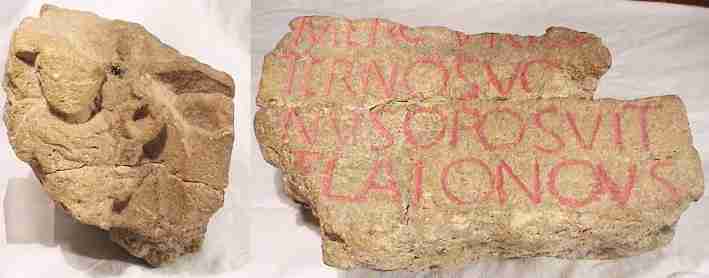 |
SOLD.
|
7789. ROMAN WEDDING RING, made of gold. The with gold dots decorated plate at the rings shows clasping hands. Diameter is 1.8 cm. Intact
|
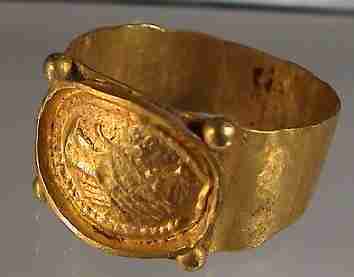 |
SOLD.
|
7790. ROMAN GOLD RING, with a carneol gem showing Fortuna. The bright red gem shows a detailed carving art.
Diameter is 1.8 cm. Superb condition. Intact.
|
 |
SOLD.
|
7791. ROMAN GOLD EARRINGS, gold round bases with a red pearls on it. Attached three goldwires with blue stones. Complete and intact. Only the red pearls are newly fixed with a silver wire. Nice types, found in Trier. About 3rd century AC. High is 2.3 cm.
|
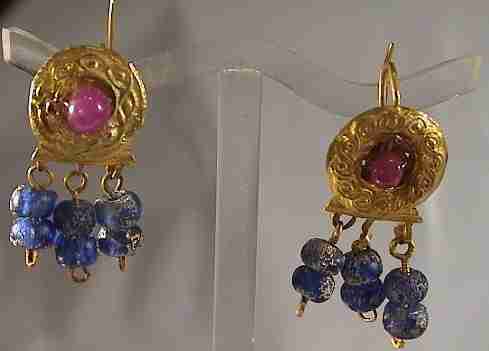 |
SOLD.
|
7792. ROMAN GOLD EARRINGS, with red gemstones. Attached goldwires with gold pearls. Complete and intact. Nice types, found in Cologne. About 2nd century AC. High is3 cm.
|
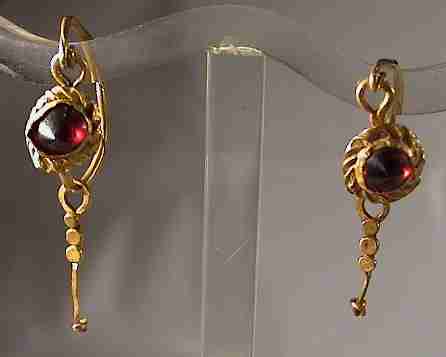 |
SOLD.
|
8141. FINE HEAVY ROMAN RING, c. 2nd-3rd century AD. The heavy orichalcum ring carefully cleaned down to its original gold colored surface looking just as it did when originally worn, functioning also as the personal seal of the wearer. 19 mm internal diameter.
|
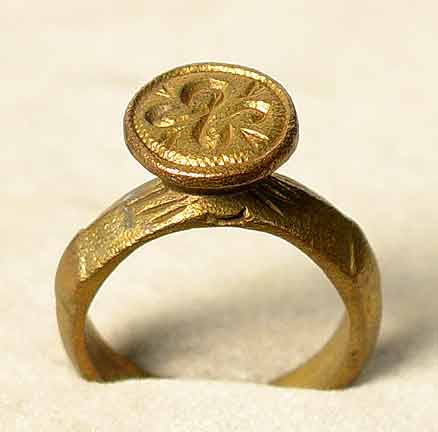 |
SOLD.
|
8147. HEAVY ROMAN STEELYARD WEIGHT, c. 2nd century BC/AD. The weight in the form of a Silenos head with heavy beard, goat ears and horns. Attachment mortise on reverse would have been filled with lead to bring to the exact weight desired. 3 x 4 inches. Nice example.
|
 |
SOLD.
|
8021. EXCEPTIONAL ROMAN BRONZE DECORATIVE NAIL, c. 1st-3rd century AD. Very unusual nail with numerous crosswise cuts along the length and star cuts on the head, also several areas of concentric notches along the length. 9 cm. The incised grooves would make the nail grip the wood tightly and have been used in a wooden construction subject to much stress such as an ornate wagon or perhaps a pleasure boat. Quite rare.
|
 |
SOLD.
|
7752. ROMAN GLASS VESSEL, made of blue glass. Intact. High is 3.5 cm, found in Neuss, upper Rhine. About 2nd century AC.
|
 |
SOLD.
|
7759. ROMAN BUST OF APOLLO, made of terracotta. Nice artwork, detailed style. High is 5.5 cm. About 2nd century AC.
|
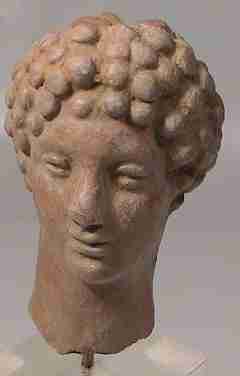 |
SOLD.
|
7760. ROMAN GLASS BOWL, imitating a Terra Sigillata bowl. Made of blue glass. Complete and intact. High is9.5 x 4 cm. About 2nd century AC, rare !.
|
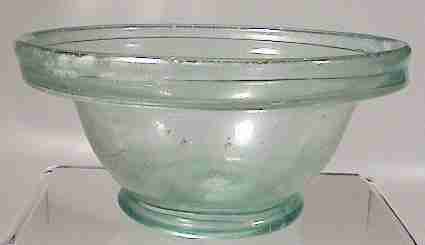 |
SOLD.
|
7762. ROMAN SEAL BOX LID, showing an eagle. Diameter is 2 cm. About 2nd century AC.
|
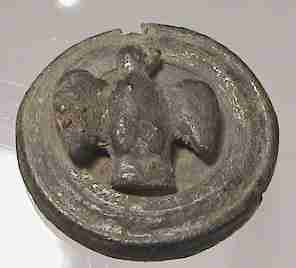 |
SOLD.
|
7764. ROMAN GLASS BOTTLE, made of blue glass. One shard at lower rim is missing. Rare bottle in typcial style. Cologne, 2nd century. High is 11 cm.
|
 |
SOLD.
|
7771. ROMAN BOWL, very early example, about 1st century. Made of brown glazed clay. Decorated with bands, the handles worked out as boar heads. Restored, one handle completed. Size is 7 x 15 cm. Rare type found in Neuss, upper Rhine.
|
 |
SOLD.
|
7772. ROMAN BOWL, in terra sigillata style. Very early type, decorated with flower ornaments. Two handles. Intact and rare. 1st century. Size is 7 x 12 cm.
|
 |
SOLD.
|
7783. ROMAN STYLUS AND WRITING TABLET. This is a very rare fragment of a roman wooden writing table together with a stylus. On the wooden tablet was a thin layer of wax. With the Stylus, they wrote in the wax. With the flat side of the Stylus the words could be erased. Both were found together in the river Rhine in Cologne. The mud (no oxygen) has preserved the wood very well. Exremly rare ensemble of writing instrument of the ancient roman times. Cologne, about 2nd century AC. Size is 14 x 3 cm on the table,15 cm in length for the stylus.
|
 |
SOLD.
|
8722. A ROMAN GLASS BEAD WITH SUPERB IRIDESCENCE, ca. 1st-3rd century. The swirled aqua-blue glass covered with suble but exquisite silvery peacock iridescence. 23mm. |
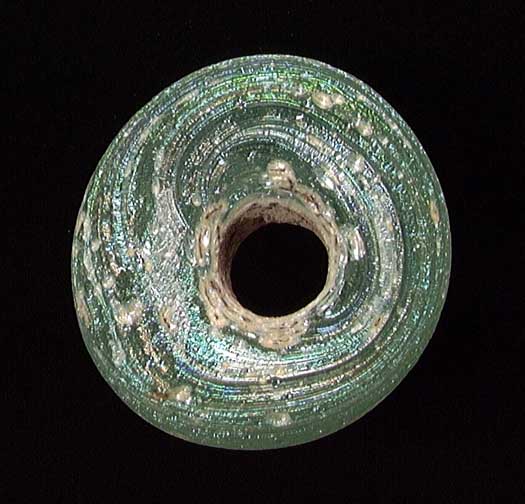 |
SOLD.
|
8856. 7 ROMAN SLING BULLETS. Holy Land, ca. 1st-3rd century. Most with molded thunderbolts visible. To 1.3". Generally nice condition. |
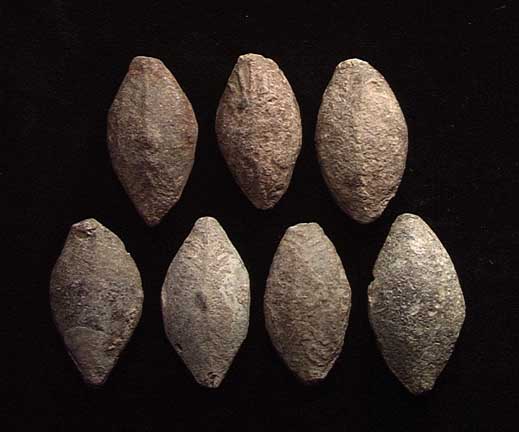 |
SOLD.
|
8524. A FINE ROMAN GOLD RING SET WITH A GARNET, ca. 1st-3rd century. 25mm. 18mm int. The garnet set to resemble an eye. Excellent condition and wearable. |
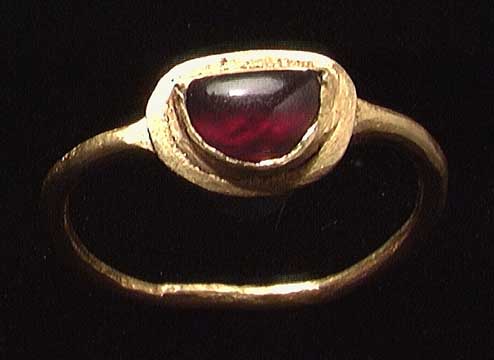 |
SOLD.
9068. AN INSCRIBED ROMAN MARBLE FIGURAL STELE. Roman Period, Eastern Mediterranean, ca. 2nd-3rd century AD. The marble slab topped by a triangular cornice with projecting akroteria, vine leaves carved in the side angles, in an alcove with arched top the figure of the deceased, a robed young man standing facing holding up an uncertain offering in this right hand, a mounting tenon at the bottom, the body inscribed with seven lines of Greek characters: ETOUSS R(P retrograde=Koppa)QM(small capital H over M)LWOU.T.I./IOLLAS OPATHR K/TATEAS HMHTHRE/TEIMHSAN IOLLAN/TONUION.EIDETISPRO/SAMARTHTWTAFW/QHSE?S TOTAMEIO(N)/C.A.F. which read "In the year 297 month Loios 13, Iollas the father and Tateas the mother
honoured Iollas the son. If someone damages the tomb, he should pay to the treasury 500 silver denaria". If the stele dates by the Sullan Era, the date could be 214 A.D. 2 x 12 x 23 inches. 35 lbs. Chips to top, otherwise nice condition with all letters of inscription readable but one or two which can be inferred.
SOLD.
|
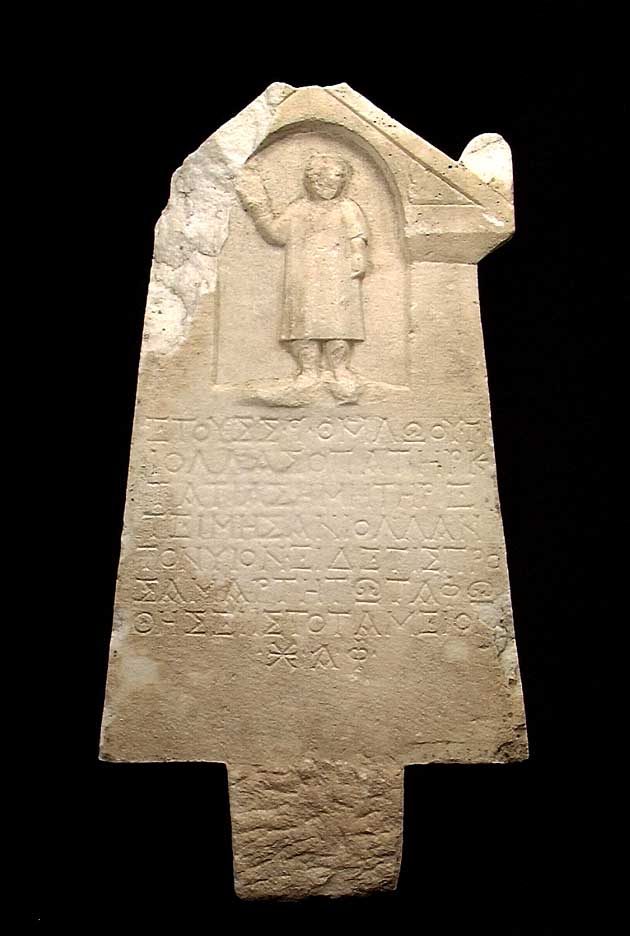
|
9087. CLASSIC ROMAN RED WARE BOWL, ca. 1st century BC/AD. The fine shallow bowl with ring base and vertical sides and covered with red glaze, a sharp plantipedia (maker's mark in the form of a footprint with stars, dots and delineated toes) impressed in the center of the tondo and the owner's incised graffito of ownership, a five pointed star incised on the bottom. 7.5". A wonderful classic example.
SOLD.
|
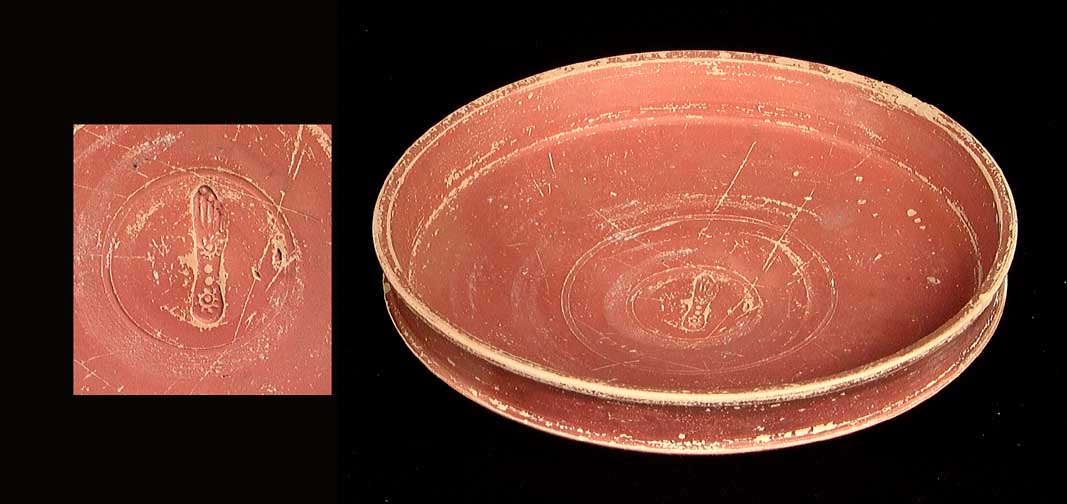
|
9717. HERCULANEUM, PAST PRESENT & FUTURE, Charles Waldstein. MacMillan & Co. London, 1908. First edition. Tall 8vo (8 x 11 x 2 inches) 324 pgs. 11 heliogravures and color prints, 48 half-tone plates. Beautifully illustrated and scholarly early work on Herculaneum. With five appendices inc. passages from ancient authors referring to Herculaneum. The city was destroyed in the eruption of Mt. Vesuvius in the year 79. Generally very nice condition with large gold stamped cover figure of Mercury attaching his winged sandals. Rare early book on Herculaneum not long after its excavation.
SOLD.
|

|
|
7869. ROMAN GOLD SERPENT RING. Lebanon/Syria, c. 1st-3rd century AD. Formed of high-carat gold in the form of a snake with incised detailing on the head, the tail wrapping over the neck. 20mm. Size is adjustable.
|
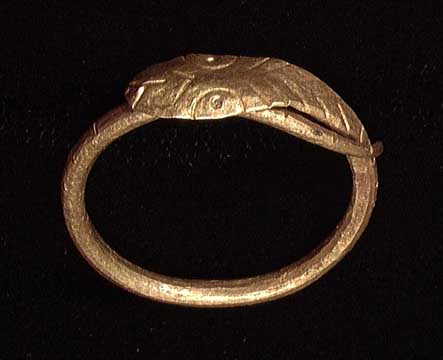 |
SOLD.
|
7871. SMALL ROMAN GOLD RING WITH CARNELIAN INTAGLIO, c. 2nd century AD. The intaglio carved with a bull's head and an amphora. Cf. Hague 916. 18 mm external diameter, 13.5mm internal.
|
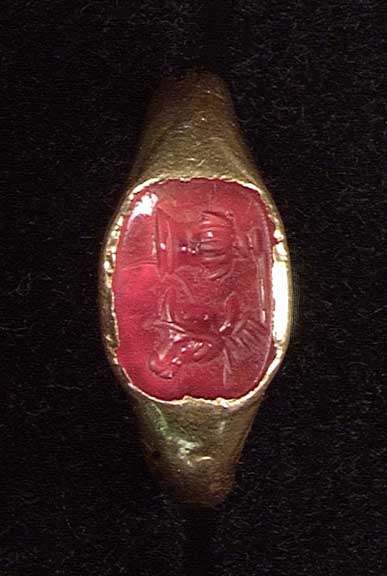 |
SOLD.
|
7788. ROMAN GOLD RING, for a child. Greek inscriptions. The diameter is 1.3 cm. Intact.
|
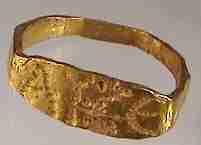 |
SOLD.
|
6447. A ROMAN GOLD PIN, ca. 1st-3rd cent. Gold pin with loop and disk at top. 1.7". Rare.
|
 |
SOLD.
|
6448. A ROMAN GOLD AND GARNET PIN. c. 1st-3rd century. The gold pin with sperical garnet bead at widened top. 2.8". Rare. The garnet is nice but does not show well in the image.
|
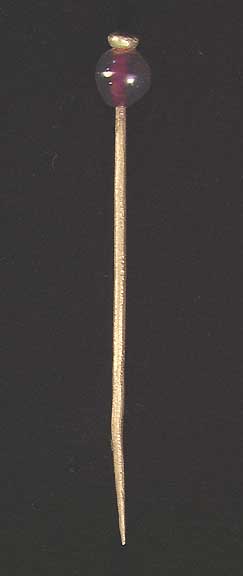 |
SOLD.
|
6449. 3 PIECES FINE ANCIENT GOLD JEWELRY. Includes Greek gold partial plaque with facing female bust and much very fine granulation, a fine Roman gold earring set with a garnet, some crushing, and a fine Byzantine gold openwork pendant with one of five interconnected granulated hemisphere crushed. To 25 mm. All examples of very fine worksmanship. A good study lot.
|
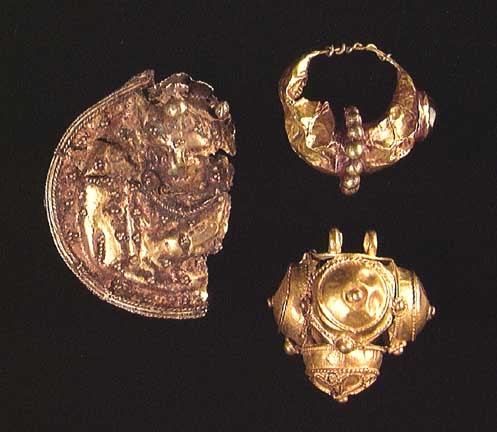 |
SOLD.
|
6450. A PAIR OF ROMAN GOLD EARRINGS, ca. 1st-3rd cent. Sheet gold over composite interior w glass beads. 24mm.
|
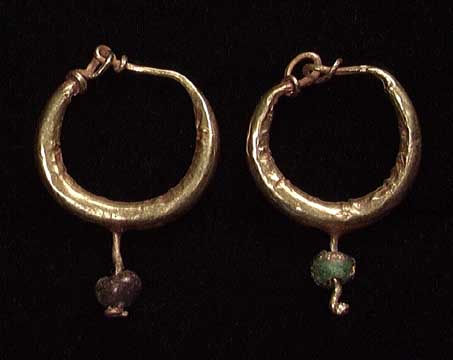 |
SOLD.
|
6451. A PAIR OF ROMAN GOLD EARRINGS, ca. 1st-3rd cent. Sheet gold over composite interior. Small cracks. 20mm.
|
 |
SOLD.
|
6315. A ROMAN HAND MIRROR, about 2nd century AC. A silvered BRONZE disc ornamented with engraved circles. The mirror has a handle in shape of a ram. The handle was found beneath the mirror but definatly belonging to it. The diameter is 9 cm, the high including the handle 3 cm.
|
 |
SOLD.
|
6316. A ROMAN INK WELL, about 1st century AC. The well is ornamented with 7 bands of small dots. The lid is missing, the well shows deposits. Nice green patina. The high is 4 cm, the diameter 3.6 cm. Interesting object of a writing set. Rare.
|
 |
SOLD.
|
6317. A ROMAN KNIFE HANDLE, about 2nd century AC. The end of the handle is worked in the shape of a panther’s head, the body is ornamented with dots and circles. The length is 4.5 cm. Nice even green patina. Interesting roman artwork.
|
 |
SOLD.
|
6318. A INTERESTING ROMAN PHALLIC APPLIQUE, about 2nd century AC. The applique is in the shape of a double lunula with the phallus at the bottom circle. A very interesting object with a good green patina. The high is 5.5 cm. Rare in this shape.
|
 |
SOLD.
|
6319. A PART OF A ROMAN BODY ARMOR, with Pegasus Detail. About 1st century AC. Retangular bronze sheet showing Pegasus flying to left. This is a typical ornamental sheet of a roman parade body armour. A small part (above the head and the wing tips) were restored. The rest is in original and uncleaned condition. Only small parts of the head and wings were cleaned to show the nice ornaments which are overall of the Pegasus. 9.5 x 11.5 cm. Rare object.
|
 |
SOLD.
|
6320. ROMAN MILITARY BELT BUCKLE, about 1st century AC. A very large large roman belt buckle of a legionary soldier. Complete with plate, intact and working. 7 cm x 6 cm ! Rare in this size.
|
 |
SOLD.
|
6321. A RARE ROMAN BRONZE RING, about 2nd century AC. The bronze ring is crowned by a small bust of Minerva wearing a corinthian helmet and a body armor. This ring was definetly owned by a roman legionary officer (showed by the military attribution). The high is 3 cm, the diameter is 2.2 cm. The ring has a small crack at the bottom. A rare object.
|
 |
SOLD.
|
6322. A ROMAN COSMETICAL INSTRUMENT, about 1st century AC. This is a classical “earspoon” of the early first century. Heavy example with nice ornaments. Wonderful green patina. The length is 12.5 cm.
|
 |
SOLD.
|
6323. A ROMAN COSMETICAL SPOON, about 2nd century AC. This type of spoons were used to ladle cosmetics out of long necked balsamaries. Green patina. The length is 17.5 cm.
|
 |
SOLD.
|
6324. A RARE ROMAN LOCK, about 1st century AC. The lock is made of BRONZE with ornaments on body. The iron shakle is gone, but the lock can be opened to show the inner mechanism which is complete. Green patina. Length: 4 cm. Rare!
|
 |
SOLD.
|
6325. A RARE ROMAN MEDICINAL CUPPING GLASS, about 2nd century AC. The cupping glass is made of BRONZE. Ornamented with engraved circles is this glass one of the rarest items of roman medicinal items. A hole on one side. Height is 3 cm, diameter 4 cm.
|
 |
SOLD.
|
6326. BUST OF MARS, about 2nd century AC. The bust is draped and wearing a helmet. 5 x 2,5 cm. Nice uncleaned applique. Good green patina.
|
 |
SOLD.
|
6327. BUST OF A BOY, about 3rd century AC. The bust on a ground plate was mounted with the hanging loop to a door to closed a large lock-hole. Dark patina. Interesting object.
|
 |
SOLD.
|
6328. TWO ROMAN WHEEL BROOCHES, bout 3rd century AC: One with much silvering remaining. Nice decorated brooches, both complete with the original pins. 3.8 and 3.6 cm in diameter.
|
 |
SOLD.
|
6329. Roman bowl, I-II c, 4.4"x 1.9".
|
 |
SOLD.
|
6330. Roman bowl, II c, 4.7"x 1.9".
|
 |
SOLD.
|
6331. Roman bowl, I-II c, 7"x 2.5", bottom chiped.
|
 |
SOLD.
|
6332. Roman bowl, II- 1/2 III c, 5"x 1.5".
|
 |
SOLD.
|
6333. Roman bowl/ cup, I c, 5.1"x 2.9".
|
 |
SOLD.
|
6334. Roman bowl/ cup, I c, 4.8"x 2.3", graffiti w inscription?
|
 |
SOLD.
|
6335. Roman bowl/ cup, I c, 5"x 2.5".
|
 |
SOLD.
|
6336. Roman juglet, II-III c, 3.8"x 3.3".
|
 |
SOLD.
|
6337. Late Roman bowl, IV-V c, 6.8"x 1.9".
|
 |
SOLD.
|
6338. Roman bowl, I-III c, 7.8"x 1.9".
|
 |
SOLD.
|
6339. Late Roman bowl, IV c, 6.5"x 1.9".
|
 |
SOLD.
|
6340. Late Roman bowl/ cup, IV c, 4.3"x 2.3".
|
 |
SOLD.
|
6341. Roman amphora, IV c, 21.3", mended from large pieces.
|
 |
SOLD.
|
6342. Roman amphora, IV c, 18.2".
|
 |
SOLD.
|
6343. Roman amphora, IV c, 22.5'', w/ dipinti in red.
|
 |
SOLD.
|
6344. Roman flagon, second 1/2 of I c, 4.6''x 5.4".
|
 |
SOLD.
|
6346. Roman juglet, II-III c, yellow engobe, mended, 4"x 3".
|
 |
SOLD.
|
6347. Roman jar, III c, 6" x 8.6".
|
 |
SOLD.
|
6348. Roman unguentarium, I-II c, 3.1".
|
 |
SOLD.
|
6349. Roman unguentarium, II- beg.III c, 5.8".
|
 |
SOLD.
|
6350. Roman unguentarium, second 1/2 of I c, 5.9".
|
 |
SOLD.
|
6351. Roman unguentarium, I- beg IIII c, 5.1".
|
 |
SOLD.
|
6352. Roman small flask, I c, 1.8".
|
 |
SOLD.
|
6353. Roman bowl, II-early III c, two applied handles, mended from two pieces, 5.3 x 2.1".
|
 |
SOLD.
|
6354. Roman flask, Rhineland, IV-V cc, 6.6".
|
 |
SOLD.
|
6355. Miniature unguentarium, I c. AD, blue, 1.6".
|
 |
SOLD.
|
6356. Roman amphoriskos, Eastern Mediterranian, I c, 2.9".
|
 |
SOLD.
|
6359. Fragment of Roman double-headed jug, late II-early III c, two-sided represent. of child's face, 1.5''
|
 |
SOLD.
|
6368. Roman bronze latch in herm form, I-II c. AD, 2.4".
|
 |
SOLD.
|
6369. Roman bronze needle and cosmetic spoon, I c AD, up to 2.9".
|
 |
SOLD.
|
6370. Roman bronze cone, I-II cc, 2.7".
|
 |
SOLD.
|
6371. Two Roman bronze cone pendants, I-III, 1.2".
|
 |
SOLD.
|
6372. Two Roman bronze pendants, I-III, cone & amphora, up to 1.6".
|
 |
SOLD.
|
6377. Roman bronze bell, I-II c., 1.6".
|
 |
SOLD.
|
6378. Roman bronze attachment, I-II c., head of Attis, 15 x 22 mm.
|
 |
SOLD.
|
6860. A SMALL ROMAN GLASS HEAD AMULET. Syria or Holy Land, ca. 1st-3rd century. The molded head of opaque black glass with suspension loop. 7 mm. Good detail with light deposit one side. Very rare and an excellent example of the glass artisan's skill. Much better than image which shows almost nothing of the piece.
|
 |
SOLD.
|
6861. A ROMAN GLASS VIAL WITH IRIDESCENCE, ca. 2nd-3rd century AD. The 'tear' vial with considerable gold and peacock iridescence, much more than shows in the image. 4.6 inches. Intact.
|
 |
SOLD.
|
6862. A ROMAN GLASS VIAL WITH IRIDESCENCE, ca. 2nd-4th century AD. The vial with spherical bottom with four pinched depressions in the sides, light silvery iridescence over most of the surface, much more than shows in the image. 3.4". Intact.
|
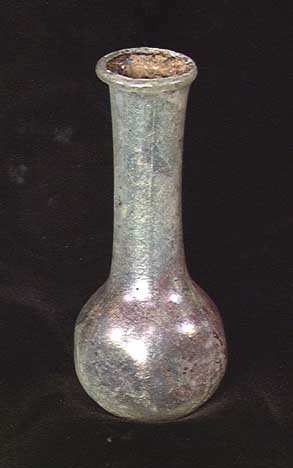 |
SOLD.
|
6866. A ROMAN MOSAIC GLASS FACE BEAD, ca. 1st-2nd century AD. The red and green glass bead with three inlaid mosaic glass faces in white and black. 20 mm. Some erosion to surface but the three faces still reasonably clear. Rare.
|
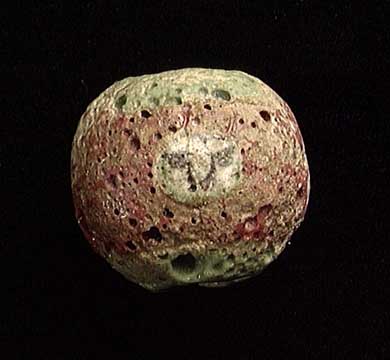 |
SOLD.
|
6868. A ROMAN PINCHED GLASS VIAL, ca. 1st-3rd century AD. The pale sea-green body with large bulge with slight central pinch and tall neck with rolled rim. 4.7". Scarce type with some iridescence. Intact.
|
 |
SOLD.
|
6869. A FINE ROMAN GLASS VIAL, ca. 1st-3rd century. With very narrow long body with rolled rim and teardrop base. 6.1". Neat repair. Very rare type with considerable pale peacock iridescence.
|
 |
SOLD.
|
6870. AN ROMAN GLASS SHIP’S VIAL, ca. 1st-3rd century. With very wide shallow body and tall neck. 3 x 5.9". Rim cut in antiquity. It has been suggested that such vessels were designed for use aboard ships where the low center of gravity would resist tipping. Rare!
|
 |
SOLD.
|
6872. A FINE ROMAN GLASS VIAL, ca. 1st-3rd century. With conical body and tall neck with rolled rim. 4.9". Tiny rim line. Excellent example covered with pale silvery peacock iridescence. Scarce.
|
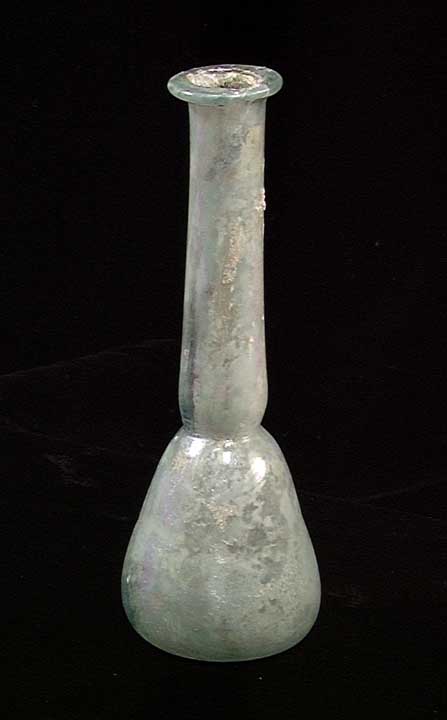 |
SOLD.
|
6873. A ROMAN GLASS BOTTLE, ca. 1st-3rd century. The bottle of pale green glass with globular body and tall neck with rolled rim. 3.3 inches. Intact.
|
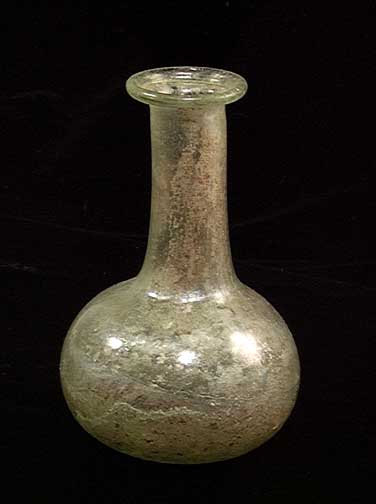 |
SOLD.
|
6875. A ROMAN GLASS BOTTLE, ca. 1st-3rd century AD. The bottle with spherical base with four pressed indendations on the sides and high neck with rolled rim. 3.1 inches. Excellent intact condition. Scarce type.
|
 |
SOLD.
|
6802. Roman Terra Sigillata juglet, II-III c. AD, red glaze, H 3.1",intact.
|
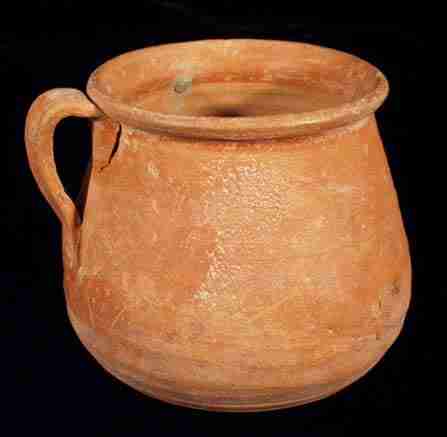 |
SOLD.
|
6803. Roman Terra Sigillata juglet, II-III c. AD, fulvous glaze, H 3.8",intact.
|
 |
SOLD.
|
6804. Roman Terra Sigillata jar, II-III c. AD, red glaze, intact, H 5.2".
|
 |
SOLD.
|
6805. Roman Terra Sigillata jar, II-III c. AD, fulvous glaze, intact, H 5.4".
|
 |
SOLD.
|
6806. Roman Terra Sigillata bowl, II c AD, red glaze, H 1.6",intact.
|
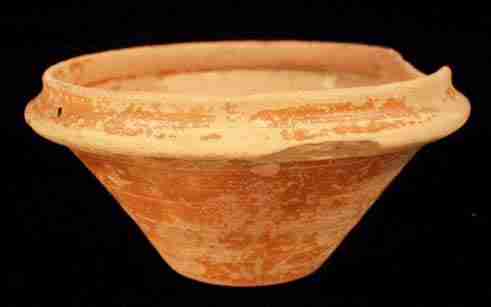 |
SOLD.
|
6807. Roman Terra Sigillata bowl, IV c AD, red glaze, H 1.7", intact.
|
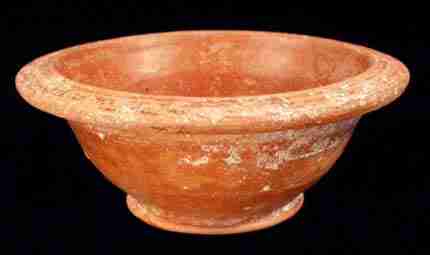 |
SOLD.
|
6813. Roman oinochoe, I c. BC, fulvous glaze, H 3.1".
|
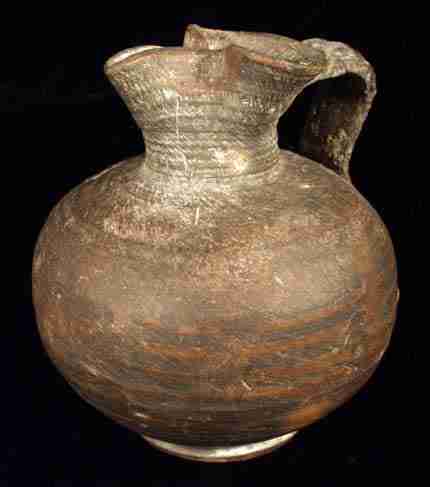 |
SOLD.
|
6816. Roman bronze pendant, II-III cc AD, 1/2 of the loop lost, 23 x 36 mm.
|
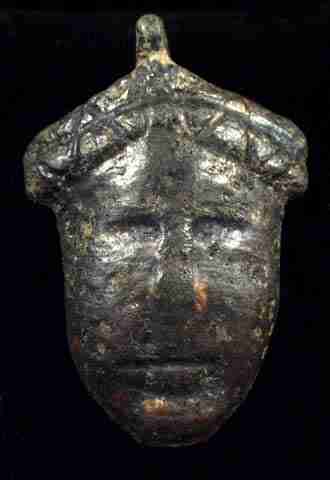 |
SOLD.
|
6818. Silver fibula, III-IV c.AD, 5 cm.
|
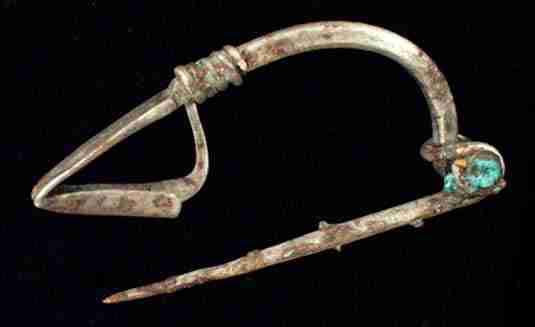 |
SOLD.
|
6819. 5 Roman fibulae, I-IV cc AD, up to 7cm.
|
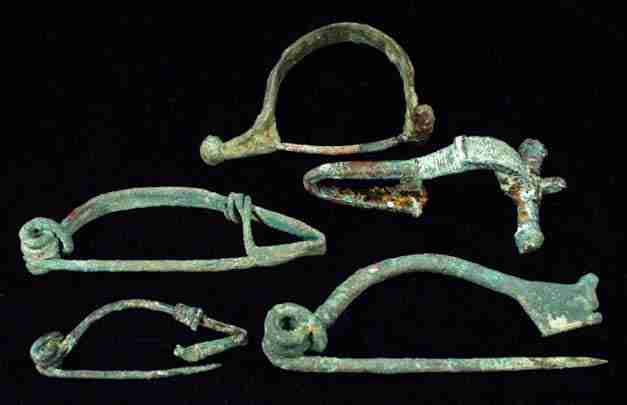 |
SOLD.
|
6820. Roman glass intaglio, I c AD, depiction of statue of Ephesian Artemis, 8 x 7 mm.
|
 |
SOLD.
|
6822. A ROMAN URN, about 2nd century AD. Made of grey clay. Typical pottery of the roman rhineland. The high is 8 cm. Some chips at rim, otherwise intact.
|
 |
SOLD.
|
6824. A ROMAN SILVERED MIRROR, about 2nd century AD. Made of bronze with the most (90%) of the original silvering remaining. The mirror is ornamented with circles and holes around the edge. Some deposits which can easily removed. The handle is, as usual, missing. The diameter is 13.5 cm.
|
 |
SOLD.
|
6826. A ROMAN COMPASS, about 2nd century. Made of bronze and fully moveable. Length is 8.5 cm.
|
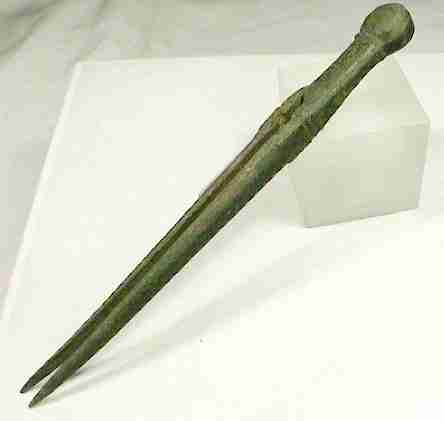 |
SOLD.
|
6828. A ROMAN GILT FIBULA, about 3rd century AD. Complete with needle. Much of the gold remaining. Interesting shape.Length is 3.5 cm. Rare.
|
 |
SOLD.
|
6829. A ROMAN MOSAIC FRAGMENT, simple white and black stones. Found at Trier. Size is 9 cm.
|
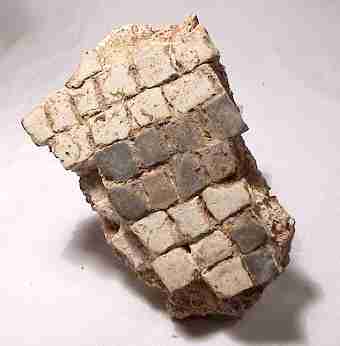 |
SOLD.
|
6830. A ROMAN MARS BUST, about 2nd century. Made of bronze. Green patina with some deposits. Comes on a custom stand. Good classical style. High is 4.2 cm.
|
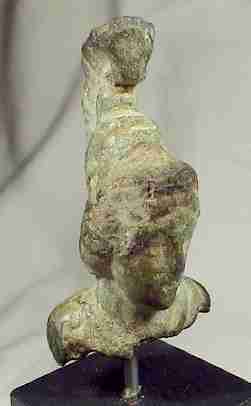 |
SOLD.
|
6831. A ROMAN NET NEEDLE, about 2nd century. A needle for manufacturing of fishing nets. Made of BRONZE with a nice and even patina. A very rare roman tool. Length is 30 cm.
|
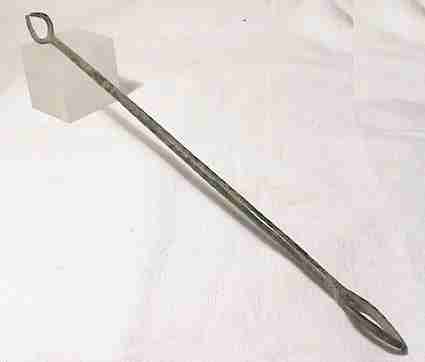 |
SOLD.
|
6835. A ROMAN COSMETIC SPOON, abot 1st century. Nice classical work with ornamented handle. Length is 16 cm.
|
 |
SOLD.
|
6847. ROMAN WALL STUCCO, about 2nd century. Three fragments of a painted wall which are showing red ornaments on a yellow and white ground. One piece shows a red and blue flower on white ground. Find spot is between Cologne and Trier.
|
 |
SOLD.
|
6849. ROMAN INSTRUMENT, maybe for spinning of wool. About 3nd century. Made of bronze with a nice green and even patina. Ornamented handle with a cock on top. Length is 17 cm.
|
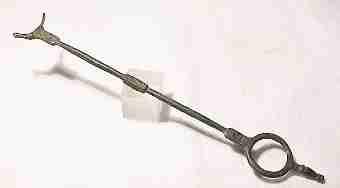 |
SOLD.
|
6850. A SET OF ROMAN CHEST FITTINGS, on a reproduction wooden chest like the Romans had used them. The chest is 28 x 30 cm. Nice green patina on the fittings.
|
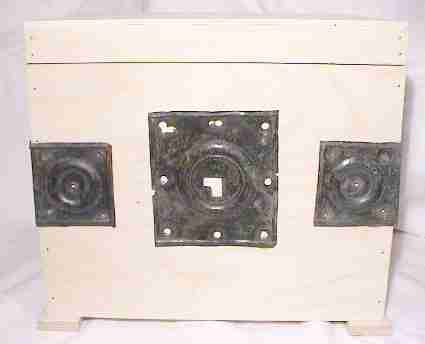 |
SOLD.
|
7373. ROMAN TERRA COTTA FRAGMENTARY HEAD OF A DOG. c. 1st-3rd century AD. What remains nice with ear perked up. 1.75 inches. features somewhat clearer than image.
|
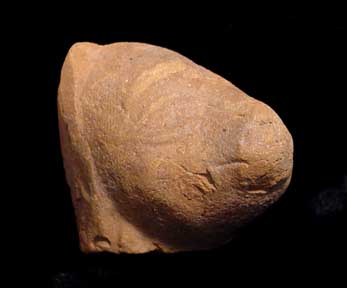 |
SOLD.
|
7531. ROMAN TERRA SIGILATA BOWL AND PLATE. Germany, c. 2nd-3rd century. The redware vessels both with signed maker's stamps at the centers. To 7 inches. The dish repaired, the small bowl a little distorted in the firing.
|
 |
SOLD.
|
7271. ROMAN MOSAIC GLASS EYE BEAD, c. 1st-3rd century AD. The bead of blue glass with 7 eyes of yellow and green rings. 12 mm. Good type.
|
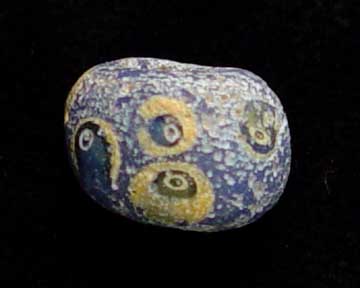 |
SOLD.
|
7408. 4 BROKEN ROMAN GLASS BOTTLES, c. 1st-3rd century AD. Restorers lot. Appears that all or most pieces are there. To approximately 3.5 inches.
|
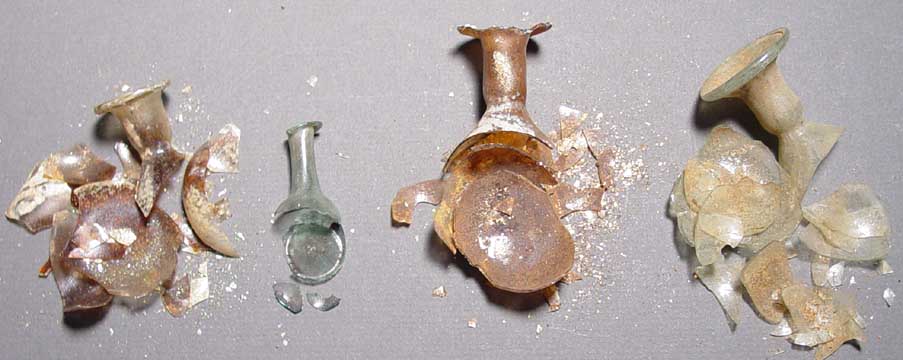 |
SOLD.
|
7409. AN INTERESTING CRUSHED ROMAN GLASS BOTTLE, c. 1st-3rd century AD. As found, crushed, the pieces stuck together by very sticky black residue of original contents. 3 inches.
|
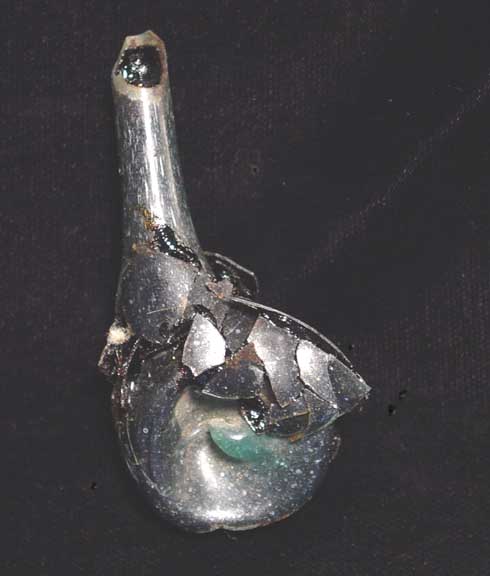 |
SOLD.
|
7411. 11 ANCIENT GLASS FRAGMENTS, c. 1st-6th century AD. Two with areas of intense peacock iridesence, one with numerous wheel cuts. To 3.25 inches.
|
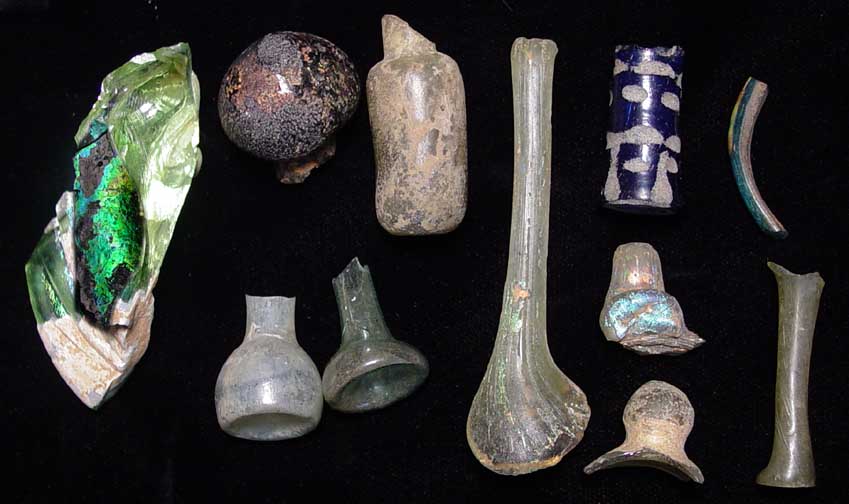 |
SOLD.
|
7412. ROMAN GLASS BOTTLE, c. 1st-3rd century AD. Pale green glass with rolled rim. 2.5 inches. Intact.
|
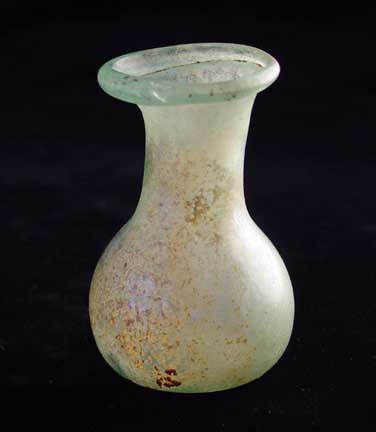 |
SOLD.
|
7612. Ziegel_putz, ROMAN WAND TILE, with painted stucco. This is a complete wand tile with white and green painted stucco from a roman villa rustica near of Cologne. Rare tile with 30 x 30 cm size.
|
 |
SOLD.
|
7793. ROMAN GOLD EARRINGS, Attached gold pearls. Complete and intact. About 2nd century AC. High is 2.5 cm.
|
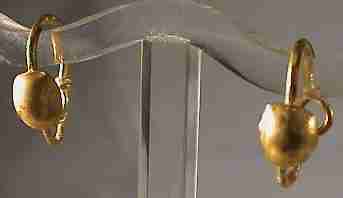 |
SOLD.
|
8140. FINE ROMAN OR EARLY BYZANTINE SILVER RING, c. 2nd-4th century AD. The ring with a rhomboid bezel on which are engraved two long-legged birds facing each other, bordered by two clusters of granulations, 20 mm internal diameter. Choice wearable condition.
|
 |
SOLD.
|
8146. SMALL ROMAN BRONZE PORTRAIT HEAD, c. 1st century AD. The small head with distinctive individual features of an actual Roman, perhaps an emperor or member of the royal family. 12 x 16 mm.
|
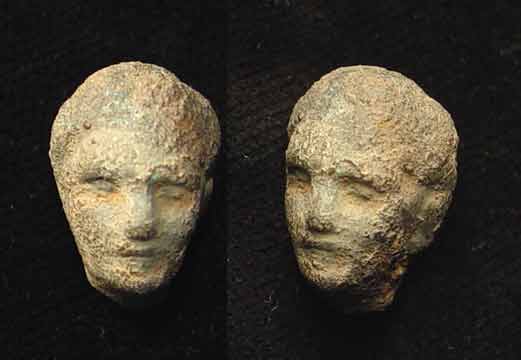 |
SOLD.
|
8149. ROMAN BRONZE LEGIONNARY EAGLE, c. 1st-3rd century AD. The sylized eagle perching with wings outspread. 1.75 x 1.75 inches. Intact.
|
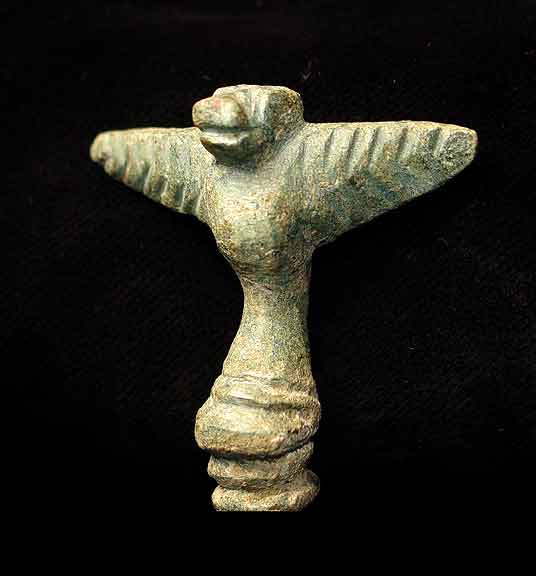 |
SOLD.
|
8019. ROMAN BRONZE CROCHET NEEDLE, c. 2nd -3rd century. The fine needle with small hook on end for pulling yarn through the weave. Rare in this state of preservation. 2.5 inches.
|
 |
SOLD.
|
8020. ROMAN BRONZE PLUMB BOB, c. 1st-3rd century AD. The bronze bob of similar form to modern types with tapering point and suspension loop. 2 inches. Rare Roman construction tool.
|
 |
SOLD.
|
7753. ROMAN MINIATURE GLASS VESSEL, made of nice blue glass. Detailed work Intact. High is 2.2 cm. About 3rd century AC.
|
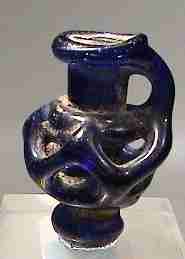 |
SOLD.
|
7754. ROMAN MINIATURE GLASS VESSEL, made of green glass. Detailed work Intact. High is 2.9 cm. About 3rd century AC.
|
 |
SOLD.
|
7755. ROMAN GLASS BOTTLE, made of green glass. The boulbous body is decorated with rims. Intact. Very nice glass bottle, found in Cologne. High is 14 cm. About 2nd century AC.
|
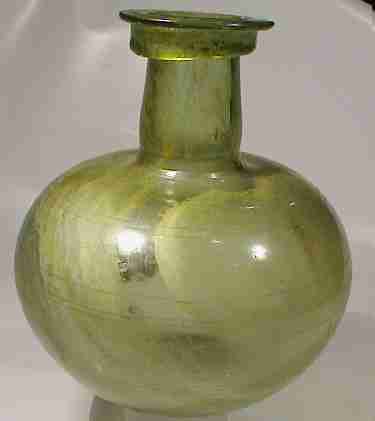 |
SOLD.
|
7756. EARLY ROMAN BEAKER, made of very thin clay. The body shows nice decoration bands of flowers and ornamentic elements. A bust is shown with the name HILARIVS beneath. 1st century. High is11.3 cm, found in Neuss, upper Rhine. Only four shards remaining, but still nice and very rare.
|
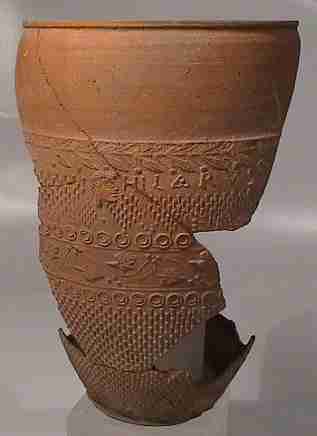 |
SOLD.
|
7757. ROMAN GLASS URGENTARIUM, made of blue glass. High is 13.3 cm, About 2nd century AC.
|
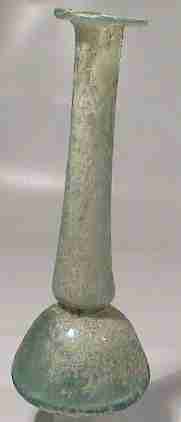 |
SOLD.
|
7758. ROMAN BRONZE SEAL, showing a man behind a goat. Found in Cologne. About 2nd century AC. High is 2.6 cm.
|
 |
SOLD.
|
7763. ROMAN SAVINGS VESSEL, made of brown clay. The lid is repaired. Very rare . Cologne, 2nd century. High is 9.3 cm.
|
 |
SOLD.
|
7765. ROMAN LEAD SEAL, showing the bust of Athena. Found in Trier. About 2nd century AC. High is 3 cm.
|
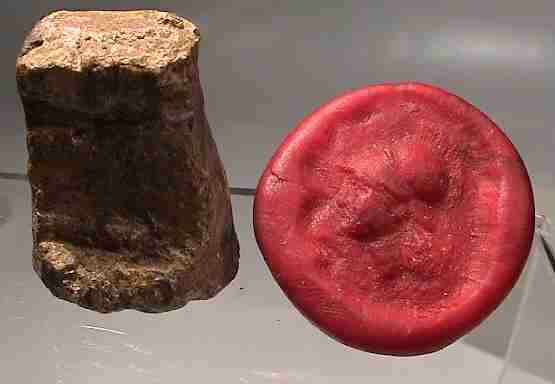 |
SOLD.
|
7766. ROMAN BONE SPOON, found in Bonn. About 3rd century AC. Lenght is 14.5 cm. Intact.
|
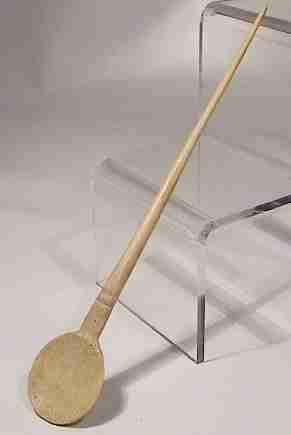 |
SOLD.
|
7767. ROMAN GLASS STAFF, for mixing of cosmetics or medical ingedients. Toroded staff, made of green glass with a hangimg loop on top. Broken one time, but nothing missing. Nice early glass work, found in Cologne. Length is 16 cm. 1st century AC.
|
 |
SOLD.
|
7768. ROMAN CROSSBOW FIBULA, made of BRONZE and silver. Very large and bold examplec of a legionary fibula with a nice green patina. The needle is the original one, but refixed. Silver wire inlays, the knobs are also made of silver. The silver is uncleaned and has a dark patina. Nice type, found in Bonn. About 3rd century AC. Length is 8.5 cm.
|
 |
SOLD.
|
7769. ROMAN TERRACOTTA STATUE, shwoing a women. Nice style. High is9.5 cm. About 3rd century AC. Length is cm.
|
 |
SOLD.
|
7770. ROMAN SWASTIKA FIBULA, complete with the original pin. Green and red patina. About 3rd century AC. Length is 3 cm.
|
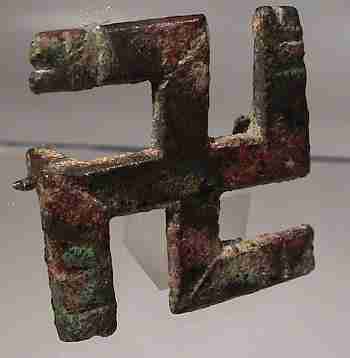 |
SOLD.
|
7773. ROMAN WEIGHT, made of clay. One side of the weight shows Fortuna, holding a cornuacopia and leaning at a column. Rare ! 2nd century, found in Cologne. Length is 3.3 cm.
|
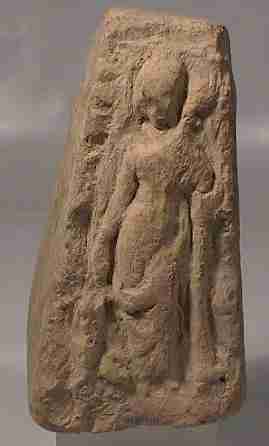 |
SOLD.
|
7774. ROMAN MARBLE FRAGMENT, showing a boy wearing a toga. About 2nd century, found in Cologne. Length is 6 cm
|
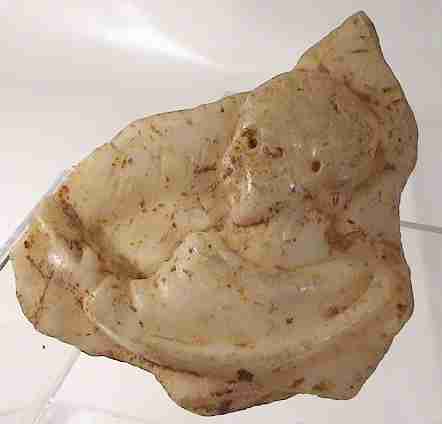 |
SOLD.
|
7775. ROMAN SLING BULLET, meade of lead. The bullet is decorated with a clear thunderbolt. Nice example. 3.3 cm
|
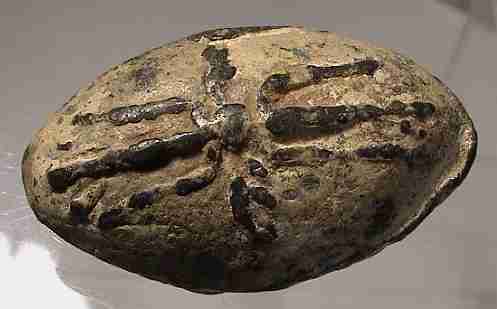 |
SOLD.
|
7776. ROMAN MIRROR, made of bronze. The bronze sheet is silvered, with nearly 100 % of the silvering remaining. Decorated with circles. Diameter is7.5 cm. About 2nd century AC.
|
 |
SOLD.
|
7777. ROMAN GODESSES, made of lead. The godesses standing in a row, holding each other. Height is 3.8 cm
|
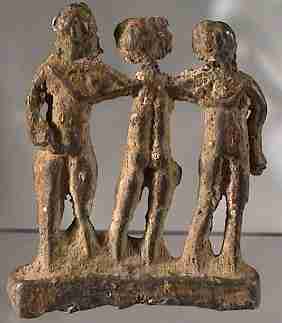 |
SOLD.
|
7778. ROMAN APPLIQUE, showing a bearded mans bust. Nice green patina. High is 4.5 cm, Trier 2nd century AC.
|
 |
SOLD.
|
7779. ROMAN TERRACOTTA STATUE, showing Mercurius. The style of the statue is very curious, because it combines typcial roman elements (Caduceus) with eastern elemets (hairdress). High is 8 cm. Interesting type.
|
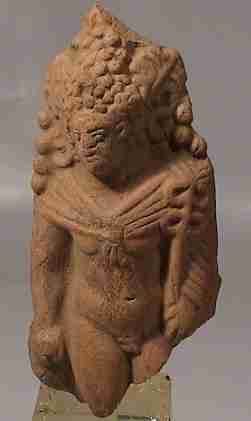 |
SOLD.
|
7780. ROMAN BRONZE SPOON, the handle is missing. The bowl ends in a ducks head. Tyical style of the 2nd century. Length is 5 cm.
|
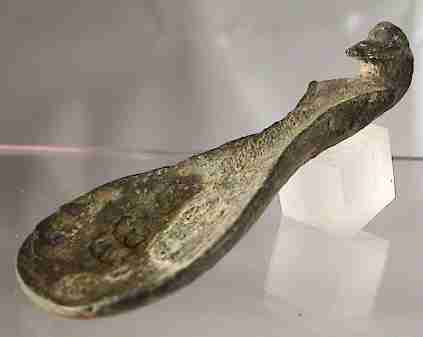 |
SOLD.
|
7781. ROMAN BRONZE TWEEZERS, very nice early 1st century style. Nice worked out handles, working condition. Complete and intact. Nice tweezers. Length is 12 cm.
|
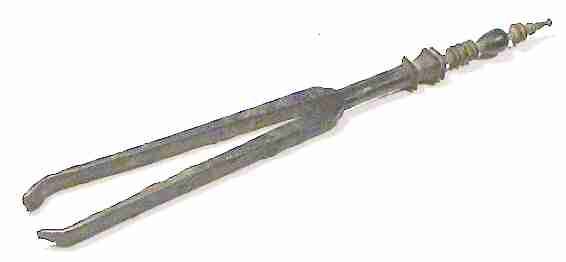 |
SOLD.
|
7782. ROMAN SILVER COSMETIC SPOON, with a nice toning. Lentght is 10 cm. About 2nd century.
|
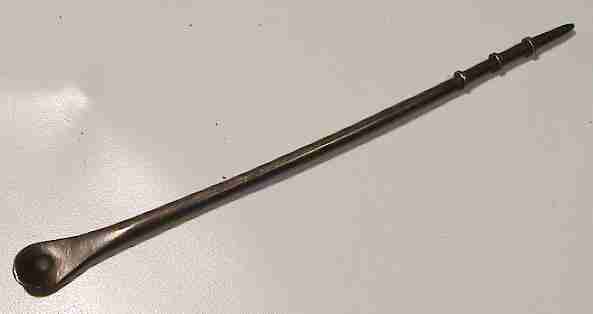 |
SOLD.
|
7786. ROMAN TILE of the 8th Legion. This legion was based in the year 24 in Pannonia and afterwards for a long time in Southern Germany. The inscription on the tile is LEG VIII AVG. Rare tile. Size is 20 x 20 cm.
|
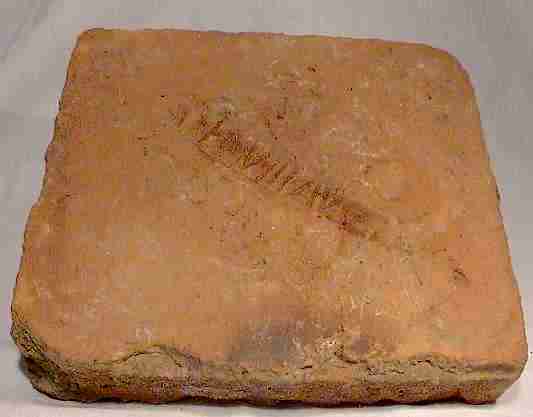 |
SOLD.
|
7787. ROMAN TILE of the 14th Legion, Carnuntum. Inscriptions reads LEG XIIII Rare tile. Size is 24 x 19 cm.
|
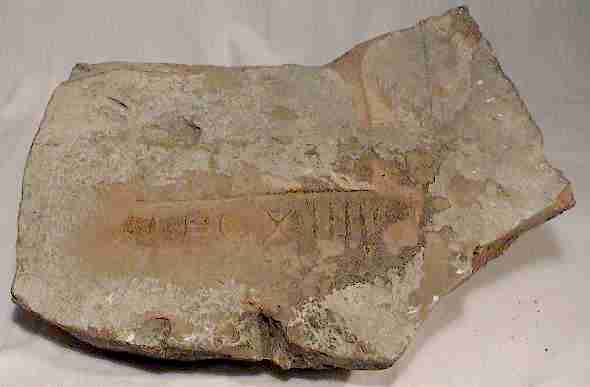 |
SOLD.
|
8300. A ROMAN BRONZE ACTOR'S MASK, ca. 1st-3rd century. The handle from a fine oil lamp. 1.5".
|
 |
SOLD.
|
8302. A ROMAN BRONZE HERM, ca. 1st-3rd century. Solid cast casket latch in the form of a herm with male organs. 3.8".
|
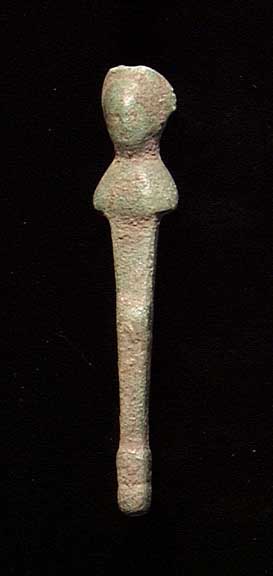 |
SOLD.
|
7743. ROMAN BRONZE RING, with a gnostic gem. The gem shows a horse head, standing on Ibis feets, carrying a cornuacopia and a kind of fruit in mouth.
If you have a close look at the body, you can see that this is building a bearded bust looking to left !
Diameter is 2.3 cm. A rare type gnostic gem ! Intact, unlceaned condition.
|
 |
SOLD.
|
7744. ROMAN SILVER RING, with a carneol gem showing the bust of Athena to left. The gem is nice and detailed worked out. The ring itself is massive. Diameter is 2.2 cm. Untouched condition. Intact.
|
 |
SOLD.
|
7745. ROMAN BRONZE RING, with a gem stone showing Minerva standing to right, holding a spear and a shield at feet. A large ring, with also a large gemstone. Diameter is 2.2 cm. Untouched condition. Intact.
|
 |
SOLD.
|
7746. ROMAN TERRA NIGRA URN, black glazed clay with a decoration band around the body. 1st century AC, found in Cologne. Repaired, no new additions. High is 9.5 cm.
|
 |
SOLD.
|
7747. ROMAN BRONZE HORSE, about 2nd century. One leg is missing, green patina. Size is is 3.5 x 3.5 cm.
|
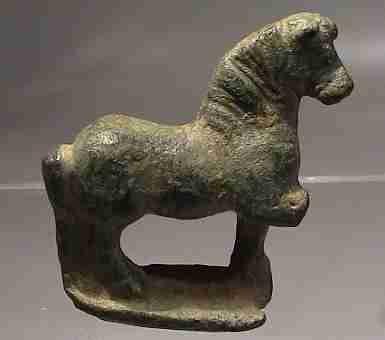 |
SOLD.
|
7748. ROMAN INK WELL, made of clay. About 3rd century, found in Cologne. High is 5.5 cm. Restored, but very rare. High is 6 cm.
|
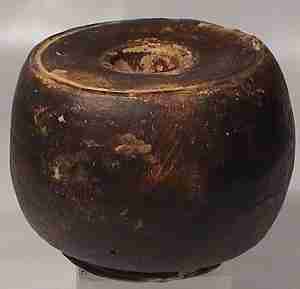 |
SOLD.
|
7749. ROMAN GLASS BOTTLE, made of blue glass. The body is decorated with bands. Nice type, found in Trier. About 3rd century AC. High is 11.5 cm. Intact !
|
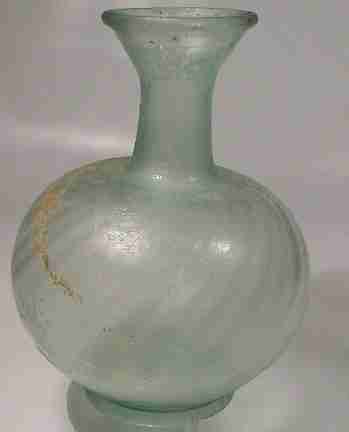 |
SOLD.
|
7750. ROMAN BRONZE EAGLE, sitting on a bulls head. Standing on 4 columns. Nice and detailed work of a legionary eagle. About 2nd century AC. High is 5 cm. Intact !
|
 |
SOLD.
|
6838. A ROMAN SAMIAN DISH, with ornamented rim (Barbotine). Some chips at the glazing, otherwise intact. Gaulish manufacturing. Diameter is 9.5 cm.
|
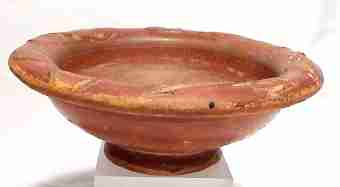 |
SOLD.
|
6839. A ROMAN SCABBARD FITTING, which was fitted at the edge of the leather scabbard of an officers gladius. Length is 8,6 cm. Nice work with green patina. Rare.
|
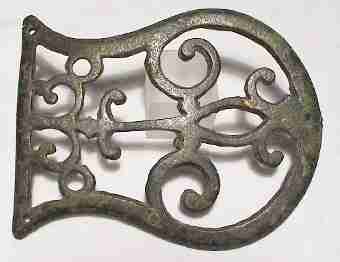 |
SOLD.
|
6840. ROMAN WALL STUCCO, about 2nd century. Three fragments of a painted wall with ornaments. Found in a Villa rustica in Germany. Rare. Sizes are 9, 5 and 5 cm.
|
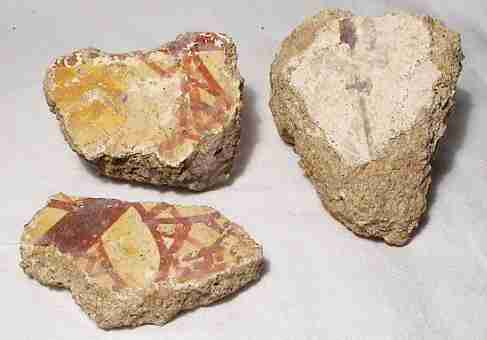 |
SOLD.
|
6854. A ROMAN BRONZE VENUS, ca. 1st-3rd century AD. She stands draped from the hips down, her hair in a bun, arranging her braids with her hands. 2.7 inches. On custom stand.
|
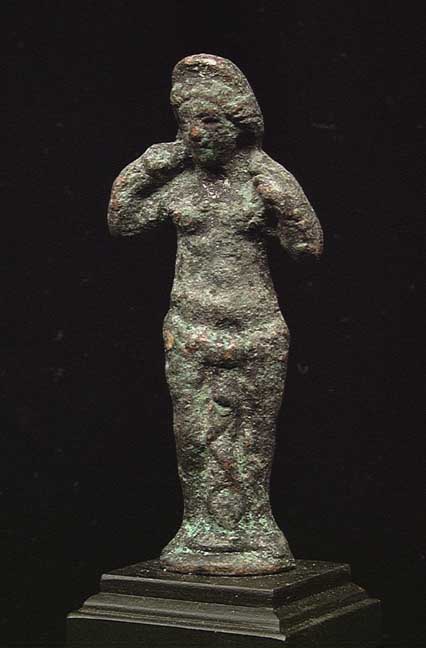 |
SOLD.
|
6855. A SPECIAL PURPOSE ROMAN GLASS BOTTLE, ca. 1st-3rd century. Rare type with high neck and the body with bottom pushing inward as a cone. Probably used to clarify some liquid from dregs. Intact with areas of silvery blue iridescence. 6.9". Perhaps with medical or apothecary use.
|
 |
SOLD.
|
6878. A LARGER ROMAN BRONZE BUST, ca. 1st-3rd century AD. The solid cast female bust with hair drawn up into a bun behind on original integral plinth. 2.75 inches. Ancient modification to mouth. On custom stand.
|
 |
SOLD.
|
6364. Roman alabastron, I-II cc AD, 3".
|
 |
SOLD.
|
6365. Roman alabastron, I-II cc AD, 2.7".
|
 |
SOLD.
|
6366. Roman bowl, II c, 3.5" x 1.9".
|
 |
SOLD.
|
6367. Roman beaker, III c, 2.6" x 3.0".
|
 |
SOLD.
|
6376. Roman bronze & carnelian ring, Hermes head left, II c, 18 mm, fragmental band.
|
 |
SOLD.
HOME >
GALLERIES >
TOP






































































































































































































































































































































































































